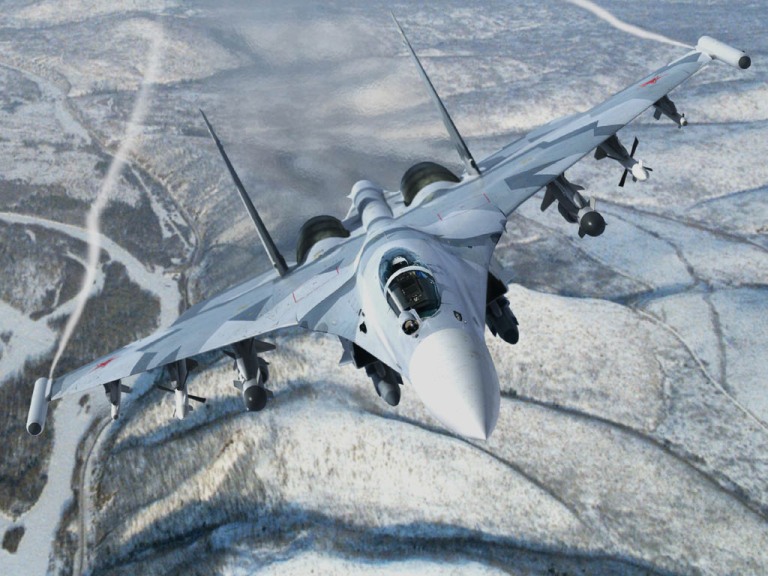 KnAAPO/Sukhoi Su-35 Flanker E of the Russian Air Force
Background
It is unfortunate that since 911 the ongoing media spectacle of the Global War on Terror and Operation Iraqi Freedom have diverted the public and media focus in Australia away from happenings in the nearer region. In recent years several important developments have taken place, with Malaysia and Indonesia signing contracts for and taking delivery of, respectively, their first top-tier Sukhoi Su-30 fighters, and India establishing production of its first fully configured Su-30MKI aircraft. While these developments were expected, they represent an ongoing change in regional aerospace power and capabilities which Australia should not choose to ignore.
Some defence analysts in Canberra have argued vocally in the media that the Global War on Terror demands that Australia fundamentally restructure its basic strategic doctrine and indeed reshape its force structure. It is proposed that the needs of coalition warfighting in distant locations should take precedence over the Defence of Australia in the nation's force structuring and funding priorities. Media comments attacking established doctrine and ridiculing it as 'Fortress Australia Policy' suggest that this perspective is more popular than one might imagine. Such reasoning is dangerous and ill informed - reflecting on the part of most protagonists of this view a weak if not wholly absent understanding of modern air power and its implicit strategic influence. To better understand how foolish this point of view actually is, we must explore more closely the capabilities of the latest Sukhoi fighters and their inherent longer term growth potential. This analysis is an updated and greatly expanded derivative of the two part series published in 2003 (see Resources). | ||
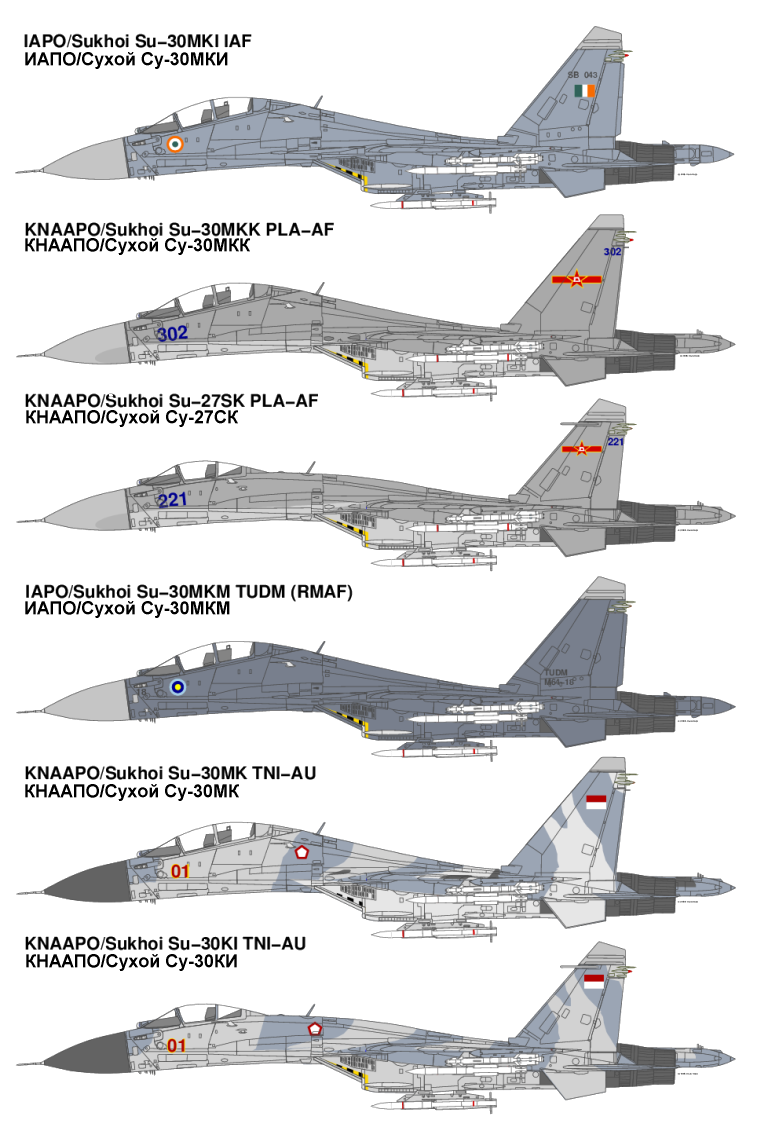 | ||
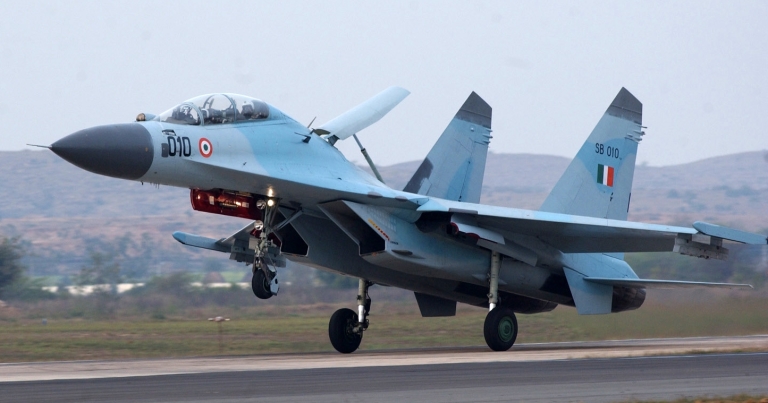
Indian AF Su-30K at Cope India (U.S. Air Force photo)
| ||
Sukhoi Su-30 DerivativesThe early history of the Su-27 family of fighters has been widely documented, and some excellent references exist (Andrei Fomin's Su-27 Flanker Story published by RA Intervestnik is arguably the single best printed reference, while Easy Tartar's reference at the Fighter Tactics Academy is the best website). The original design aim of the Perspektivnyy Frontovoy Istrebitel (PFI - Future Tactical Fighter) was to kill the US Air Force's then new F-15A, and both the Sukhoi and Mikoyan bureaus submitted designs. The Sukhoi T-10 concept emerged in the early 1970s, and was conceptually closest to a fusion of the fixed wing Grumman VFX-404 configuration with the blended strake/wing/body configuration of the GD LWF demonstrator, later to become the F-16A. From the outset the design was to use various combinations of mechanical-hydraulic and Fly By Wire (FBW) controls with some reduced static stability to achieve exceptional manoeuvrability. The early T-10-1 demonstrator evolved into the current T-10-15/Su-27 configuration through an almost complete but necessary redesign during the early eighties. The result has been the most aerodynamically refined of all of the third generation fighters. Like the MDC F-15A, the basic design was devised from the outset to accommodate both single and dual seat configurations. The Su-27UBK tandem dual trainer airframe became the basis of the Su-30 series. 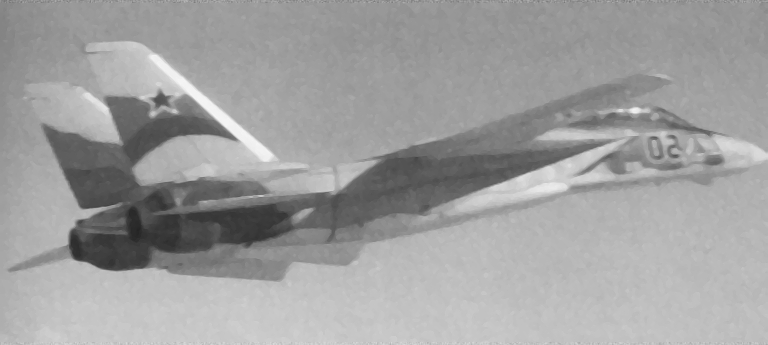 Introduction into PVO-S (Protivo-Vozdushnaya Oborona Strany - air defence force) and FA (Frontovaya Aviatsia - tactical air force) service was protracted, especially due to problems with manufacturing an airframe with a substantial amount of titanium alloy and honeycomb laminates, but also due to difficulties with the complex F-15-like avionics package. To demonstrate the aircraft's potency as an F-15 killer, the Sovs in 1986 stripped and modified the T10-15 prototype, redesignated it the P-42 and promptly took out no less than 22 FAI records, mostly in the time to height categories previously held by the F-15A. Such impressive basic performance results from the exceptionally clean aerodynamic design and the pair of large Lyulka AL-31F series afterburning turbofans - the P42 would have used early variants of the engine. 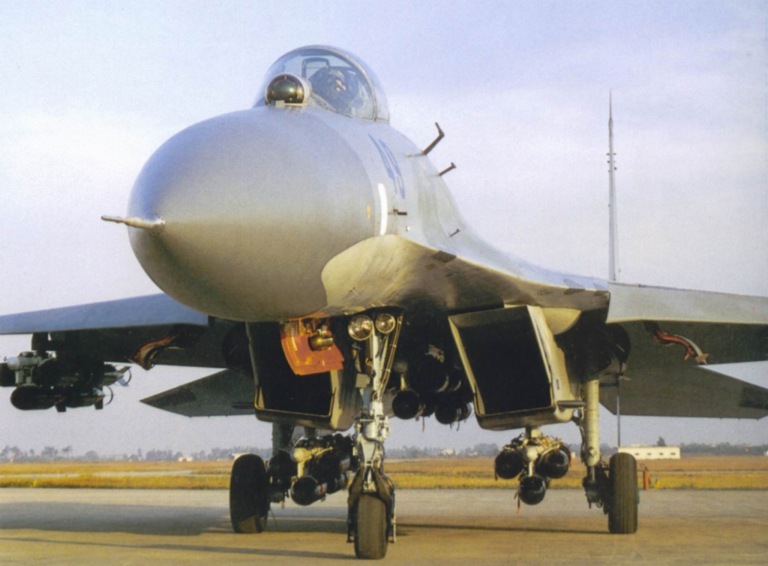
Chinese PLA-AF Su-27SK Flanker B
The baseline Su-27 airframe resulted in two nearly identical variants for the PVO and FA, the Su-27 and Su-27S Flanker B, with a common dual trainer in the Su-27UB Flanker C. The single seat Su-27/Su-27S was manufactured by the KNAAPO plant at Komsomolsk-on-Amur and the dual Su-27UB was manufactured by the IAPO plant at Irkutsk, with design authority remaining at the Sukhoi bureau. The principal distinction in the Frontal Aviation Su-27S was a capability to deliver dumb bombs and rockets - not unlike the F-15A/B/C/D models. Both types were to carry the large pulse Doppler Myech air intercept radar, which was to use a mechanically steered planar array antenna with electronic vertical beam steering, but production aircraft with the NIIP N001 used a simple mechanically steered cassegrain antenna.Several early derivatives of the Su-27 are of much interest since they paved the way for the production Su-30 subtypes new seen in the Asian export market. The navalised Su-27K Flanker D, K for 'Korabl'ny', was developed for the Project 1143.5 55,000 tonne class aircraft carrier, of which four were to have been built. The Su-27K had beefed up undercarriage with twin nosewheels, upgraded hydraulics, a tailhook, enlarged flaperons, a modified ejection seat angle, folding outer wings and stabs, upgraded FBW, modified LERX (Leading Edge Root Extensions) with canards, enlarged leading edge slats and a deployable aerial refuelling probe. The refuelling probe modification included a pair of deployable floodlights in the nose, used to illuminate the tanker aircraft, here intended to be either an Il-78 Midas or another Su-27 buddy tanker carrying a centreline UPAZ hose-drogue pod. The probe permits a fuel transfer rate into the fighter of up to 4,000 lb/min. Another notable Su-27K feature to migrate to later variants was the right offset IR Search and Track housing, this improving the pilot's downward view over the aircraft's nose. Production Su-27Ks operated by the Russian Navy are often designated the 'Su-33'. Perhaps the most important feature of the Su-27K/Su-33 are the enlarged LERX/canards which increase the available body lift of the aircraft, and the centre of pressure forward thus enhancing achievable pitch rates. The Su-27 series shares with the F-14 series a large body lift capacity resulting from the wide fuselage tunnel - as a result the aircraft's effective wing loading is much lower than that of aircraft with different configurations. This is reflected in superb high alpha handling and sustained turn rates. | ||
 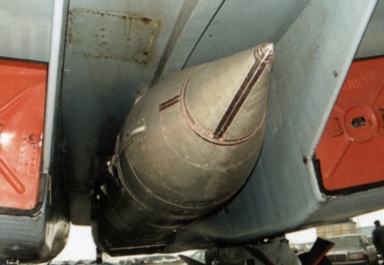 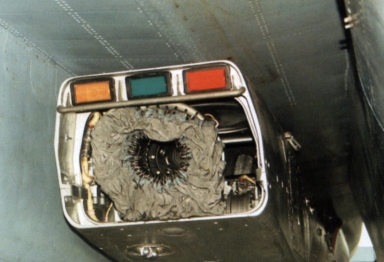 The side-by-side dual navalised trainer was so successful it evolved into the F-111 like Su-32/34 Fullback series bombers, intended to replace the Su-24 Fencer. [Click for more] The Su-33 Flanker D has now been ordered by the PLA-N for trials on the refurbished former Soviet Project 1143.5 carrier Varyag. It is expected that around 50 aircraft will eventually be acquired to equip an air wing. 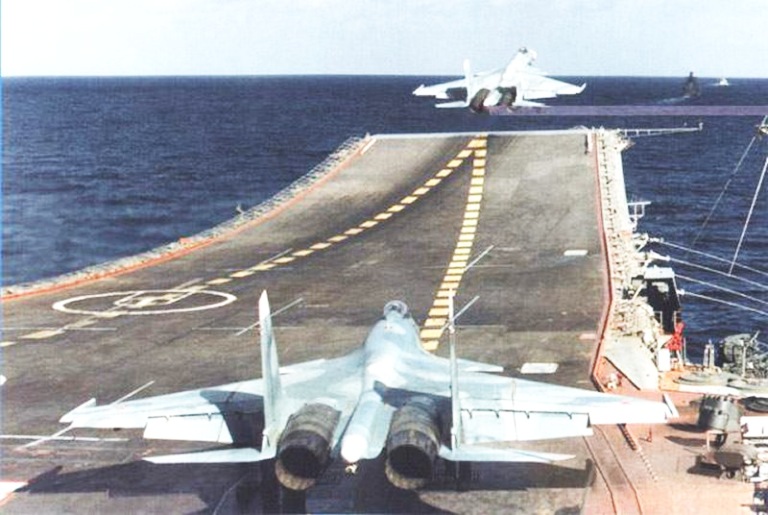 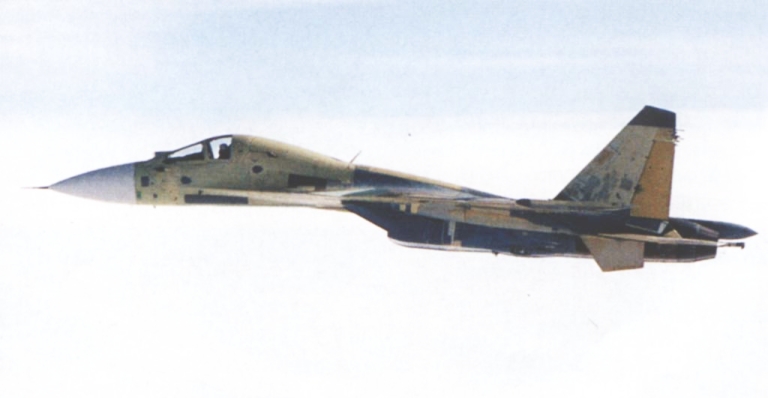  | ||
While the navalised Sukhois spawned key aerodynamic design innovations in the series, the land based variants accounted for most of the avionic and propulsion improvements. The most important early derivative was the dual role single seat Su-27M strike fighter, frequently labelled as the Su-35. Initiated in 1982, the baseline Su-35 best compares to the F-15C in basic capabilities. It was to be the initial platform for the then new Vympel R-77 AMRAAM-ski active radar guided AAM. The Su-35 was to carry a complete EWSP package, a cockpit wide angle Head Up Display (HUD), triple MFDs, an improved RSLU-27/N011 fire control radar package using a new slotted planar array antenna rather than the N001 design, an N012 tail warning radar, an improved OLS-27K Infra-Red Search/Track (IRST), the Schchel-3UM Helmet Mounted Sight (HMS), ShO-13A Doppler nav, an inertial nav package, air/air and air/ground GCI (Ground Control Intercept) datalinks, two additional inboard wing hardpoints to permit up to 12 external stores, and the aerial refuelling probe.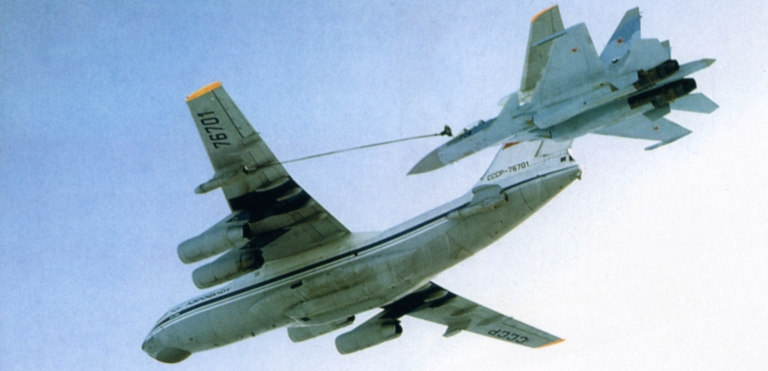
Su-27M/Su-35 Flanker E and Il-78 Midas tanker. Note the UPAZ-1A pods (RuAF). Further images.
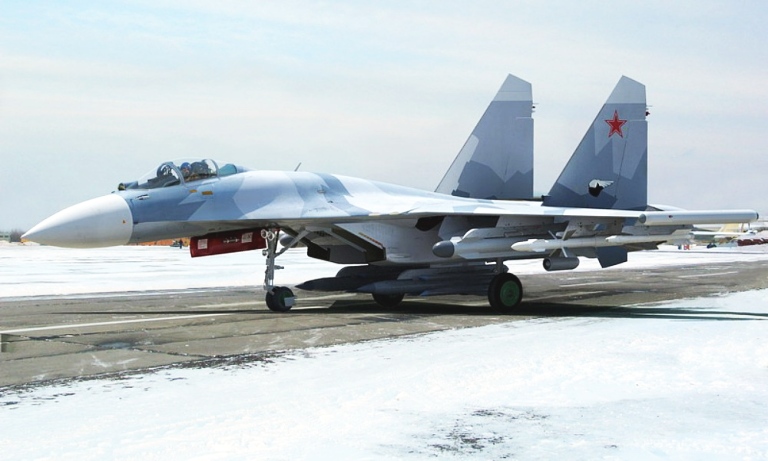
Rollout of the first Su-35BM Mid Life Upgrade configuration Flanker E, January 2007 (MilitaryPhotos.net)
The Su-37 was to incorporate two important advancements over the Su-27M/35. These were thrust vectoring nozzles and the new NIIP N011M passive shifter technology ESA (Electronically Steered Array - phased array). In addition, an electrical sidestick controller was mounted in the right side of the cockpit. The Lyulka bureau designed the first axisymmetric two dimensional thrust vectoring (2D TVC) nozzle ever deployed during this demonstration program - the nozzle Time Between Overhauls (TBO) is reported at 250 hours vs the 1,000 hr TBO for the AL-31FP core. 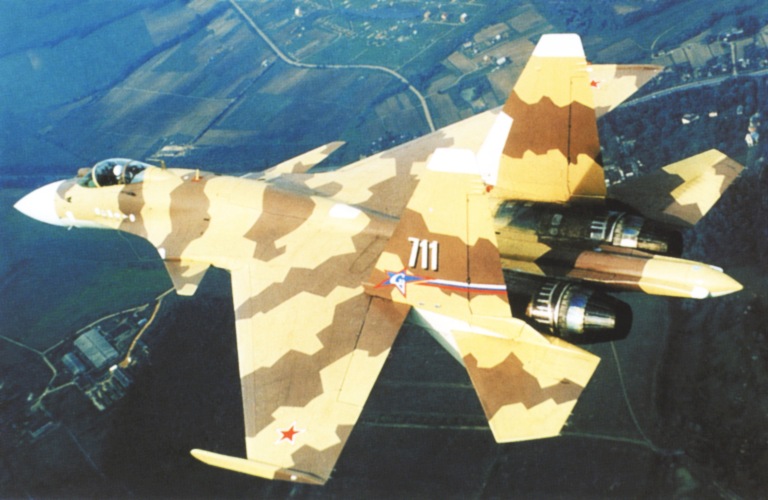 The all important Flight Control System (FCS) in the Su-27 family evolved incrementally, with the first generation hybrid analog system running in parallel with the conventional hydro-mechanical design. The Su-37 introduced a genuine redundant digital system, similar in concept to its contemporary Western designs.The Su-30 series is not directly evolved from the Su-27M line, but has incorporated many design features demonstrated in the Su-27M/35/37 line. The origins of the Su-30 lie in the last years of the Soviet era, when the PVO sought a combat capable derivative of the existing Su-27UB conversion trainer. The dual variant was to be equipped for aerial refuelling and used as a long range / long endurance interceptor and combat command and control fighter to lead long range CAPs. The aircraft was initially designated the Su-27PU (Perekhvatchik - Uchebnoy) and later relabelled the Su-30. The Su-30 was developed in part by the Irkutsk plant, responsible for manufacturing the Su-27UB. The export variant of the Su-30 was designated Su-30MK and unveiled in 1993 - as a multirole strike fighter rather than interceptor. | ||
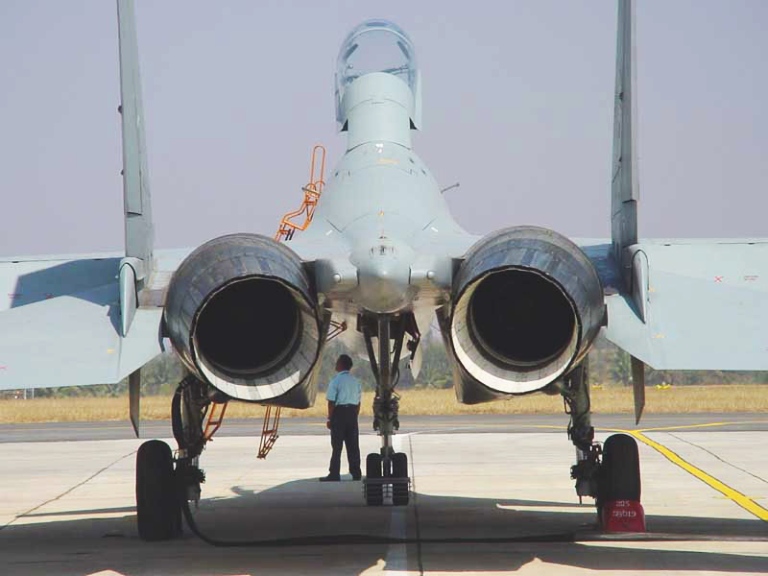 Irkut/Sukhoi Su-30MKI Flanker H. Further images. | ||
| The hard sell by the Irkut (formerly IAPO) and Sukhoi paid off in late 1996 when the Indian Air Force signed for an advanced derivative of the baseline Su-30, the Su-30MKI (M-Improved, K-Export, I-India) Flanker H. In a complex deal which saw initial deliveries of basic Su-30K and progressive development and later delivery of full configured and licence build Su-30MKI, India negotiated a deal which will see around 180 of these aircraft deployed with IAF squadrons. The Su-30MKI is a fusion of technology from the Su-37 demonstrator and Su-30 program, with additional Indian designed and built processor hardware in the Mission Computers, Radar Data Processor provide under the Vetrivale (Lance) industry program, and some items of Israeli and EU hardware. The aircraft has a Sextant Avionique HUD and RLG (Ring Laser Gyro) INS/GPS, glass cockpits, NIIP N011M phased array, AL-31FP TVC engines, enlarged rudders, Su-33/35/37 canards and aerial refuelling probe, and an improved OLS-30 IRST package. The Indian developed Tarang RWR is used in the EWSP suite. The TVC system in the Su-30MKI has evolved beyond the Su-37 system, which deflected only in the vertical plane. The Su-30MKI variant has a 32 degree canted TVC plane to introduce a lateral and vertical vectored force component, and is driven by the engine's fuel system rather than main aircraft hydraulic loop. Since 2003, more details have also been revealed about the N-011M BARS ('Panther') hybrid phased array radar designed for the Su-35/37 and supplied on the Su-30MKI and likely the Su-30MKM. The BARS phased array assembly is mechanically steerable to +/-55 degrees off-boresight, providing a total field of regard in azimuth of +/-100 degrees off-boresight - in effect the combination of mechanical array steering and electronic beam steering provides full forward hemispherical coverage. NIIP claim a 3 dB noise figure three channel receiver, and an average transmit power of 1.2 kW, with 1 kW in illuminator mode for semi-active missiles. Air-air modes include Track While Scan for 15 targets and concurrent engagement of four, raid assessment and Non-Cooperative Target Recognition (NCTR). Air-surface modes include real beam mapping, Doppler beam sharpening, Synthetic Aperture Radar (SAR) imaging, Ground/Maritime Moving Target Indicator (GMTI/MMTI), target position measurement and GMTI tracking of two concurrent targets. Aerial fighter sized targets have been acquired at 76 NMI, and moving tanks at 25 NMI. While reports of an Active ESA (AESA) have surfaced, details are as yet not available to the public. The Indian Su-30MKI is to date the most advanced Su-27 derivative to enter production and with the exception of mission avionics and software is a credible equivalent to the F-15E/I/K/S family. It also underscores the 'no holds barred' international arms market, in which an export customer is supplied with a product which is half a generation ahead of the Russian air force - the IAF designates it as its Air Dominance Fighter. 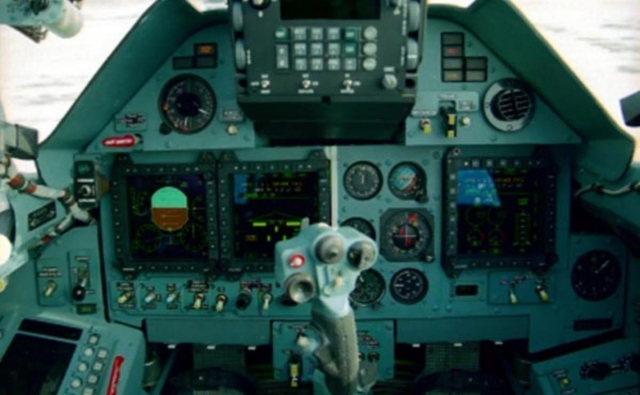 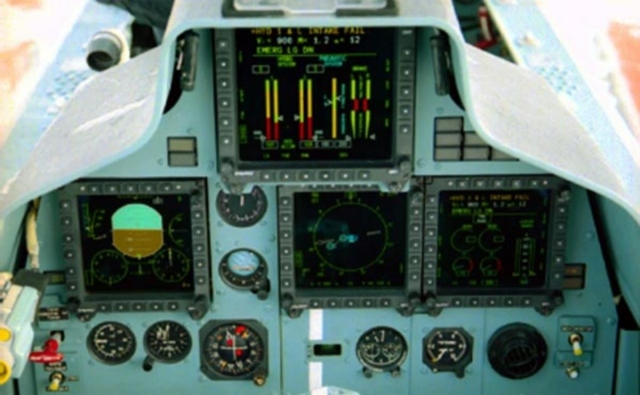
Irkut/Sukhoi Su-30MKI Crew Stations.
However, the greatest Sukhoi export success to date has been KNAAPO's deal to supply and licence build Su-27SK Flanker Bs and Su-27UBK Flanker Cs for the Chinese PLA-AF - also the very first export deal for the aircraft. The initial order was for 20 x Su-27SK and 4 x Su-27UBK, essentially the same configuration as Soviet Frontal Aviation units flew but claimed to be fitted with Phazotron Zhuk rather than the NIIP radars. A second batch of aircraft was, numbering 16 x Su-27SK and 6 x Su-27UBK. was supplied in 1996, bringing the fielded total to 46. That same year KNAAPO were awarded a contract to set up licence production of the Su-27SK at the Shenyang plant in the PRC - these are designated as the J-11 and up to 250 may be built. An additional buy of twenty or more imported Su-27UBK dual trainers was reported in 2002.India's buy of the Su-30MKI triggered a response in Beijing - the PLA-AF ordered around 50 Su-30MKK Flanker G fighters from KNAAPO. The KNAAPO Su-30MKK is not the same as the Irkut Su-30MKI in configuration, despite the shared Su-30MK designation. The baseline Su-30MKK the Su-35/37 vertical tail design, no canards, no TVC capability, Russian avionics and a variant of the Phazotron Zhuk planar array radar. An improved OEPS-31E-MK IRST package is fitted. There are reports the aircraft has an increased maximum takeoff weight against the Su-30/Su-30MKI, requiring structural changes. Like the PLA-AF Su-27SK the Su-30MKK uses the original analogue FCS. The Su-30MKK is a KNAAPO development which is closest in concept to a dual seat Su-35 without the canards added to the production Su-35. It is like the Su-35 a dual role fighter, occupying the same niche as the F-15E but less accurate and less capable in the air-air role as the Su-30MKI. 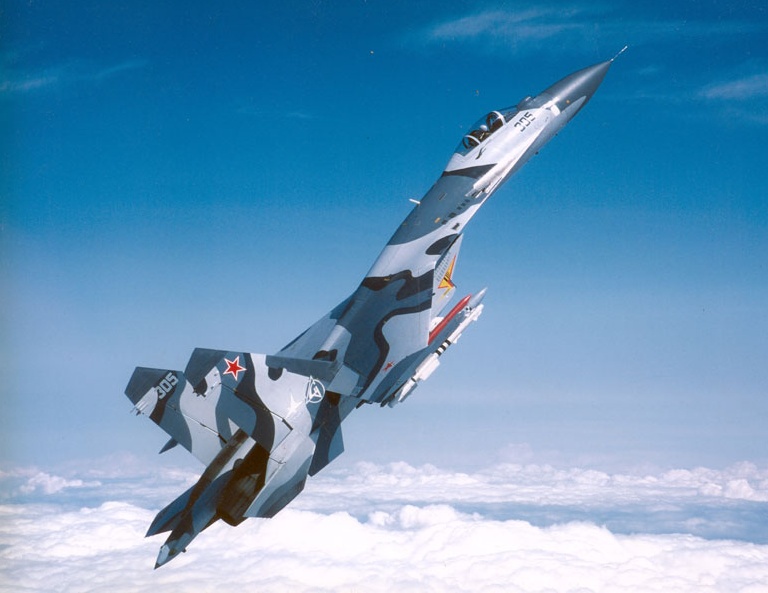
KnAAPO/Sukhoi Su-27SKM Multirole Flanker Prototype. Further images.
The PLA-N Air Arm was evidently not satisfied with the domestically built JH-7 Flying Leopard strike fighter, and opted to expand its fleet by acquiring the Su-30MK2, a derivative of the Su-30MKK, with a rated maximum takeoff weight of 85,000 lb. The Su-30MK2 has an enhanced weapon system optimized for maritime strike, built around the N-001VEP radar. The radar will target the Kh-31A ramjet supersonic anti-shipping missile, and a radar seeker equipped variant of the Kh-59, designated the Kh-59MK2. A radar guided derivative of the Kh-59M, the Kh-59Mk, was also developed for the PLA-N Flanker G. Chinese sources claim that 36 Su-30MK2 aircraft were ordered, with deployment as yet undisclosed. Venezuela is acquiring this variant.The Russians were reported to have been developing a third PLA variant of the Su-30, the Su-30MK3. The Su-20MK3 was to incorporate the 'Panda' upgrade package for the N-001 radar, including a signal processor upgrade based on COTS software and a Ts-100 processor, and the new Pero phased array. The Pero, developed by NIIP and Ryazan GRPZ, is a reflective passive phased array antenna, replacing the legacy cassegrain design. It is lighter than the legacy design, but offers similar beamsteering agility to the latest Western AESAs. Recent reports suggest this program is no longer funded. The PLA-AF was dissatified with the limitations of the Su-27SK/J-11 and renegotiated the licence arrangement to have the latter 100 aircraft delivered as the Su-27SKM (also reported as SMK) variant. The principal improvement is that the Su-27SKM incorporates all of the refinements of the multirole Su-30MK variants, and can thus support guided munitions, making it equivalent to proposed but never built single seat multirole derivatives of the F-15E. As such the Su-27SKM can carry the full suite of air to ground munitions now carried by the Su-30MKK series. The radar configuration has not been disclosed but may include the Pero passive phased array. Another possible alternative is a derivative of the developmental Phazotron AESA, reported to have been tested with a 0.7 metre array size on the MiG-29. The Chinese also recently unveiled the 'indigenised' J-11B, incorporating Chinese technology, specifically the Woshan-10A (WS-10A) engine replacing the AL-31F, the Shedian-10 radar replacing the N-001, and the PL-12 (SD-10) BVR missile replacing the R-77 and R-27, and a range of indigenous guided munitions replacing the Russian types. It is likely that the J-11B will be introduced to production on completion of the J-11 build. 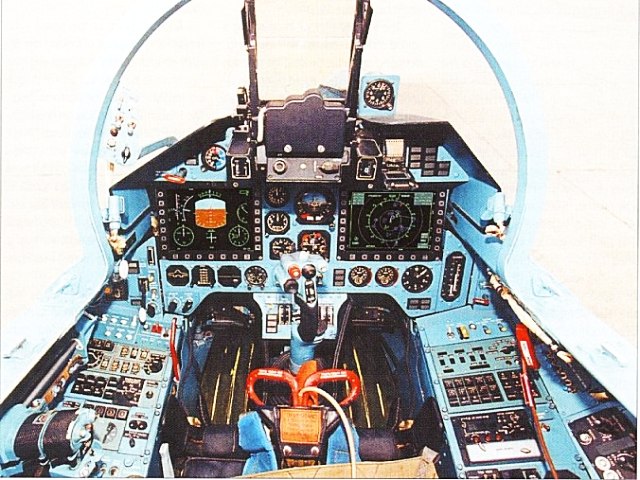 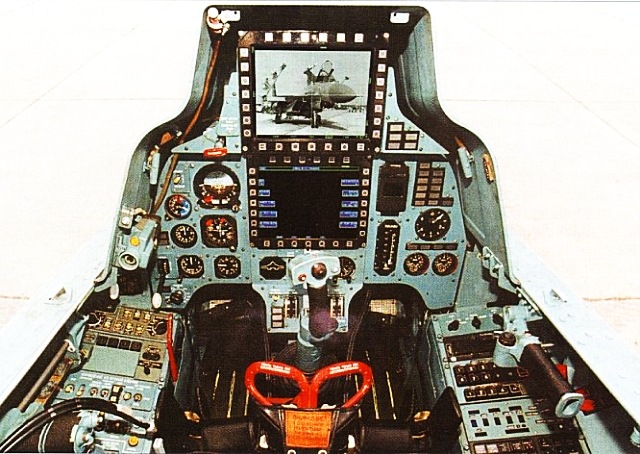
KnAAPO/Sukhoi Su-30MKK Crew Stations.
Russian sources put the current total supplied to the PLA-AF as 76 x Su-27SK/UBK, 50 x Su-30MKK with outstanding orders for 19 more, and a commitment for licence production of around 200-250 aircraft. Russian estimates of the ultimate size of the PLA-AF Su-27/30 fleet fall between 350 and 500 aircraft. For comparison, the US Air Force fielded around 400 F-15Cs and 200 F-15Es, putting the PRC's orders into a similar force structure size bracket - and almost twice the size of the Indian Su-30MKI fleet. Malaysia committed in 2003 to purchase 18 Su-30MKMs beating the Boeing F/A-18F bid - evidently Malaysia's bilateral MiG-29 support relationship with India exposed the RMAF/TUDM to Indian Su-30MKI program and they liked what they saw. The Su-30MKM is being supplied by Irkut and will therefore be close in configuration to the Su-30MKI, although as yet no details are available on the specific fit of the MKM variant - it is known that some French avionics will be used. The aircraft were to be delivered from 2006, but reports in 2006 indicated the aircraft remained parked in Russia pending payment. It is likely that a large portion of the deal will be financed by barter of Malaysian industrial and consumer goods. Indonesia's TNI-AU has had a long standing interest in the Sukhoi fighters and prior to the Asian economic crisis committed to purchase the Su-30KI. This aircraft was to be supplied by KNAAPO and was derived from the single seat Su-27SMK, a Mid Life Upgrade design package for the baseline Su-27S. The Su-30KI is thus an improved single seat Su-27S, with the improved N001E radar and cassegrain antenna, aerial refuelling probe, centreline OLS-27 IRST, ILS-31 HUD, and provisions for the R-77 Adder missile. This variant is more the air superiority fighter than dual role strike fighter and is essentially a low cost upgrade of the basic production KNAAPO Su-27 line - the use of the early configuration centreline IRST installation suggests the Su-30KI may be built from refurbished low time PVO Su-27 airframes. In late April 2003, Indonesian President Megawati signed an MoU with Russia for the supply of four Sukhoi fighters, two Su-27SK and two Su-30MK (some sources claim Su-35, others Su-30KI) to the Indonesian TNI-AU later this year. Media reports from Jakarta indicated that the TNI-AU intends to acquire between 48 and 54 of these aircraft over this decade, and often report the inclusion of an aerial refuelling capability - part of the Su-30KI configuration. Whether the TNI-AU aircraft are Su-27SKs, Su-35s, Su-30KIs or Su-30MKs is immaterial in the longer term, since the basic KNAAPO/Irkut T-10 family of designs permits incremental retrofits, and cash permitting any of these variants can over time morph into a more advanced model. Since then the TNI-AU had its four aircraft delivered. In 2006, Indonesian President Susilo Bambang Yudhoyono visited Moscow and ordered an additional six aircraft, as part of a larger arms package. | ||
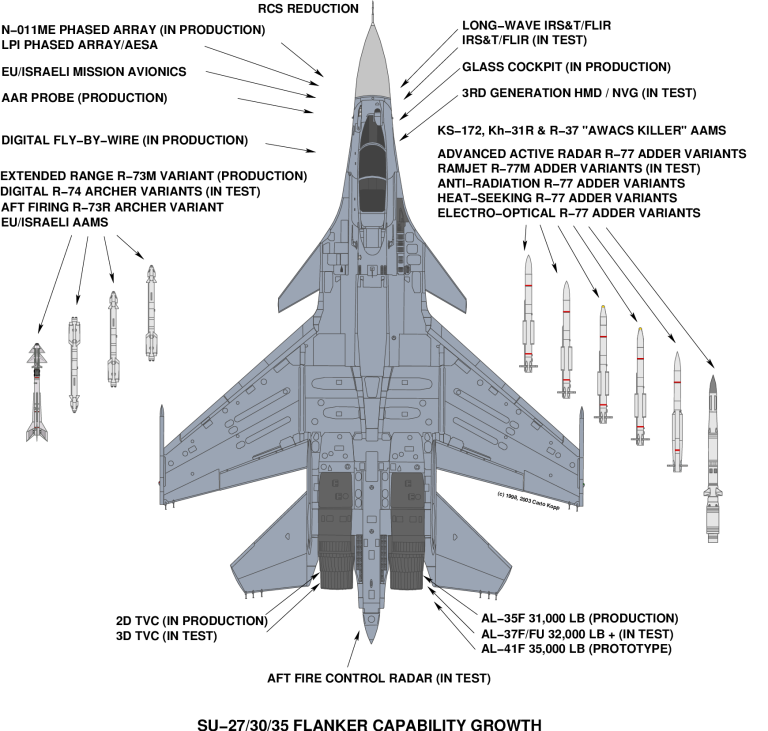 | ||
Su-30 Growth Paths
The Su-27/30 series is by far the aerodynamically most refined of the third generation fighters in the market and is a direct equivalent to the late build F-15E/I/K/S variants. While it does not offer quite as good top end supersonic performance and handling to the F-15, it makes up for this with exceptionally good low speed high alpha handling and performance.
From an 'information age' warfighting perspective, the basic Su-30 series airframe has some very attractive features absent in competing Western third generation fighters.
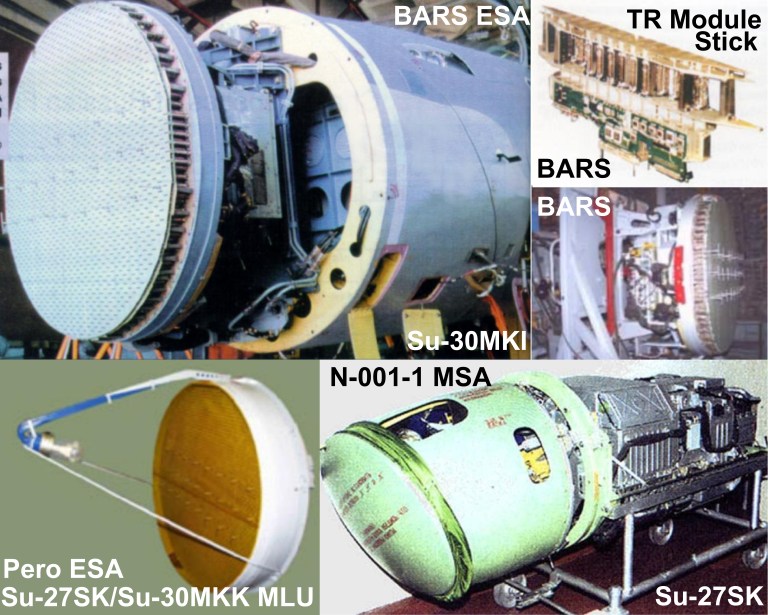
The NIIP N011M BARS phased array is the most capable fighter radar produced by Russian industry and is designed to support the R-77M family of ramjet missiles. The NIIP Irbis-E is an evolution of the BARS using a 20 kW ganged TWT transmitter and increases range performance significantly. The depicted detection range curves are based on publicly disclosed Russian performance figures for co-altitude BVR engagements. It is evident that inside the 10-20 nautical miles envelope the radar will be able to challenge aircraft with quite good stealth characteristics. The curves for the Agat 9B-1103M and 9B-1348E seekers are based on the most recent Agat data release, and include the TMS320 equipped digital variant. The 9B-1101K has not been included (Author - NIIP, Phazotron, Agat data).
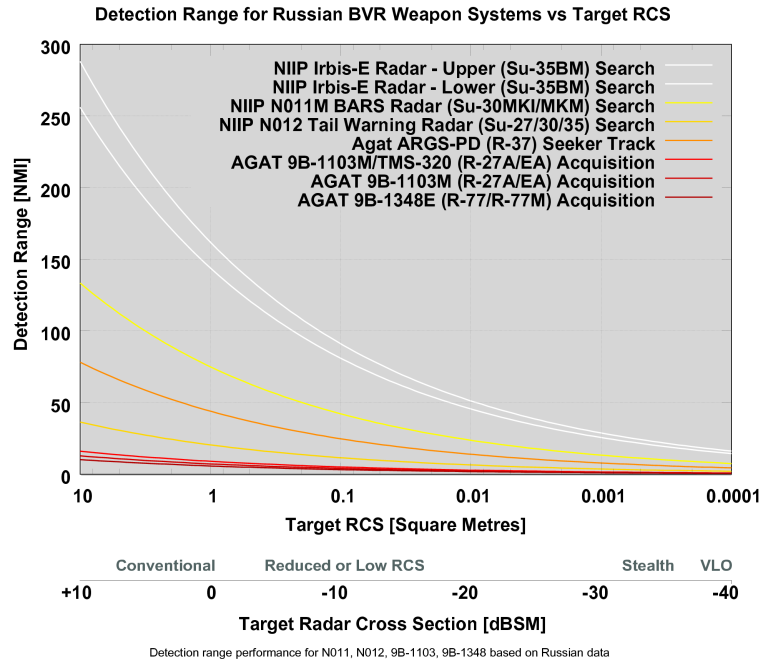 Radar
The first of these is its massive radar bay, capable of fitting a 1 metre class X-band phased array antenna. In the long range BVR combat game, radar range is a key factor and for any given radar technology, the larger the aperture the better. While the current N011M/ME BARS (Panther) and Pero (Plume) upgrades use passive array technology which delivers less peak power than competing active arrays (AESA) it is only a matter of time before NIIP and Phazotron adapt commercial GaAs MMIC technology (98% of the total GaAs chip market) to build an AESA variant competitive against the AESAs in the latest Western evolved 3rd Gen fighters.
With similar TR (Transmit-Receive) module performance, the fighter with the largest aperture size wins in this game - for instance the N011M has around twice the aperture size of the JSF AESA and F/A-18E/F's APG-79 and even with inferior TR module technology will be highly competitive. It is worth noting that India is only the fourth nation worldwide to field a phased array equipped aigile air combat fighter, after France, the US and Russia.
Electrical power and liquid cooling have been issues for the integration of AESAs in Western fighters, especially so with smaller types like the F/A-18E/F, F-16E/F and Joint Strike Fighter. This is not an issue given the sheer size of the Flanker.
While the existing N011M has limitations in its older technology back end processing, the future is the path India has followed, retrofitting third party hardware with better performance than the Russian processor hardware. With widely available commodity processor chips in the 1 to 2 GHz class, we can expect to see many other Sukhoi users emulate the Indians in coming years, be it in MLUs or new build aircraft.
The baseline N011M radar uses a vertically polarised 0.9 metre diameter aperture hybrid phased array, with individual per element receive path low noise amplifiers delivering a noise figure cited at 3 dB, similar to an AESA. Three receiver channels are used, one presumably for sidelobe blanking and ECCM. The EGSP-6A transmitter uses a single Chelnok Travelling Wave Tube, available in variants with peak power ratings between 4 and 7 kiloWatts, and CW illumination at 1 kW. Cited detection range for a closing target (High PRF) is up to 76 NMI, for a receding target up to 50 NMI. The phased array can electronically steer the mainlobe through +/-70 degrees in azimuth and +/-40 degrees in elevation. The whole array can be further steered mechanically. Polarisation can be switched by 90 degrees for surface search modes. 
NIIP Irbis E Prototypes (above, below)
NIIP Irbis E Components (above)
The follow on to the BARS is the new Irbis-E (Snow Leopard) hybrid phased array, in development since 2004 and planned for the Su-35 block upgrade, and as a block upgrade or new build radar for other Flanker variants. The Irbis-E is an evolution of the BARS design, but significantly more powerful. While the hybrid phased array antenna is retained, the noise figure is slightly worse at 3.5 dB, but the receiver has four rather than three discrete channels. The biggest change is in the EGSP-27 transmitter, where the single 7 kiloWatt peak power rated Chelnok TWT is replaced with a pair of 10 kiloWatt peak power rated Chelnok tubes, ganged to provide a total peak power rating of 20 kiloWatts. The radar is cited at an average power rating of 5 kiloWatts, with 2 kiloWatts CW rating for illumination. NIIP claim twice the bandwidth and improved frequency agility over the BARS, and better ECCM capability. The Irbis-E has new Solo-35.01 digital signal processor hardware and Solo-35.02 data processor, but retains receiver hardware, the master oscillator and exciter of the BARS. A prototype has been in flight test since late 2005.
The performance increase in the Irbis-E is commensurate with the increased transmitter rating, and NIIP claim a detection range for a closing 3 square metre coaltitude target of 190 - 215 NMI (350-400 km), and the ability to detect a closing 0.01 square metre target at ~50 NMI (90 km). In Track While Scan (TWS) mode the radar can handle 30 targets simultaneously, and provide guidance for two simultaneous shots using a semi-active missile like the R-27 series, or eight simultaneous shots using an active missile like the RVV-AE/R-77 or ramjet RVV-AE-PD/R-77M. The Irbis-E was clearly designed to support the ramjet RVV-AE-PD/R-77M missile in BVR combat against reduced signature Western fighters like the Block II Super Hornet or Eurofighter Typhoon. Curiously, NIIP do not claim superiority over the F-22A's APG-77 AESA, yet their cited performance figures exceed the public (and no doubt heavily sanitised) range figures for the APG-77.
The existing N011M series lacks a Low Probability of Intercept capability, in part due to antenna bandwidth limits and in part due to processor limitations. This is likely to change over the coming decade, with the Irbis-E, as customers demand an ability to defeat or degrade Western ESM equipment and the technology to do this becomes more accessible.
In terms of block upgrades, of the two competing radar houses in Russia, NIIP (http://www.niip.ru/) and Phazotron, the former has been the most active of recent. A block upgrade package, designated 'Panda' was recently developed for the baseline N-001-01 radar carried by Su-27S/SK. The first stage is the N-001V back end upgrade using C/C++ COTS software and a Ts-100 processor.
Of more interest however is a low cost phased array block upgrade package designated Pero ('Plume'), designed jointly with Ryazan GRPZ. This lightweight design avoids the cost and complexity of the backplane fed BARS (N-011M) phased array, instead using a space (optical) feed scheme, and reflective rather than transmissive phase elements, a technique used with the 64N6E Big Bird SAM system radar. The design incorporates the phase element array, and a strut supported boom which mounts the X-band waveguide and radiating horn. Cost is comparable to the existing Su-27S/SK Cassegrain antenna, weight is lower. The launch customer is the RuAF, but reports indicate one of the two prototypes was sent to China for evaluation. The Pero will provide the beam steering agility of modern Western AESAs, but with lower cost and transmit power ratings, and is likely to appear in regional MLUs later this decade. An open question is whether a future Pero based block upgrade would include the 20 kiloWatt Irbis-E transmitter, as engineering the space feed for a 20 kiloWatt rated transmitter is neither difficult nor expensive. While a 20 kiloWatt Pero system would have inferior receiver sensitivity due to the space feed loss, compared to the BARS hybrid array, it would be significantly cheaper to build and deploy en masse. In summary, near term we can expect to see the Irbis-E and Pero appear in new build and upgrade packages, in the longer term an AESA is an inevitability. Electro-Optical Systems
Another attractive design feature of the Flankers is the large IRST housing, which can fit an aperture larger than competing Western IRST systems - the more photons the IRST can capture, the greater its detection range potential. The baseline OLS-27 IRST can scan a 120x75 degree field of regard, and cover as field of view as narrow as 3x3 degrees but has poor sensitivity with a head on detection ranges cca 8 nautical miles. The integrated laser rangefinder is effective to about 1.5 nautical miles. Specifications for the OLS-30 have not been disclosed - it is known that further development is under way on an IRST/FLIR design similar in concept to the Eurofighter's Pirate system. As with radars, IRST and FLIR aperture size matters, and the Sukhoi is in a commanding position with the existing OLS-27/30 package. With commercial technologies such as Quantum Well longwave/multiband imagers of 800x600 pixel resolution in the EU market, it is only a matter of time before this technology finds its way into an OLS-30/31 derivative. Current US IRSTs using older MCT imaging arrays have detected fighters at distances of many tens of miles.
The advent of HDTV compatible CCD and CMOS daylight imaging devices in COTS applications opens up the possibility of a dual band derivative of the OLS-27/30 package, longer term. Cockpits, Computers and Networking
The cockpit of the existing Su-30 series provides plenty of opportunities for further growth, both in display technology and back end processing. With militarised commodity AMLCD display panels becoming increasingly available, the trend we have observed with the Sextant displays in the MKI is likely to grow over time, driven by the need to compete against US and EU cockpit designs. We should not be surprised to see India and Israel become prominent in the Sukhoi MLU market. The same will be true of mission computer equipment.
Upgrades available for Su-27/30 include the encrypted TKS-2/R-098 (Tipovyi Kompleks Svyazi) Intra Flight Data Link (IFDL) which permits the networking of up to 16 Sukhoi fighters. It is not known whether the 5U15K-11 datalink designed for networking the A-50 AWACS and MiG-31 has been adapted to the Su-27/30, or whether a unique equivalent design is used. The TKS-2 was used effectively during the 2004 Cope India exercise against US F-15Cs.
Maturity in flight control software has seen aggressive improvements in types such as the F/A-18E/F, and it is reasonable to surmise that the adoption of digital FBW controls in recent Su-30 variants will see similar evolution in the Sukhoi types - especially given the Russian obsession with close in manoeuvre performance.
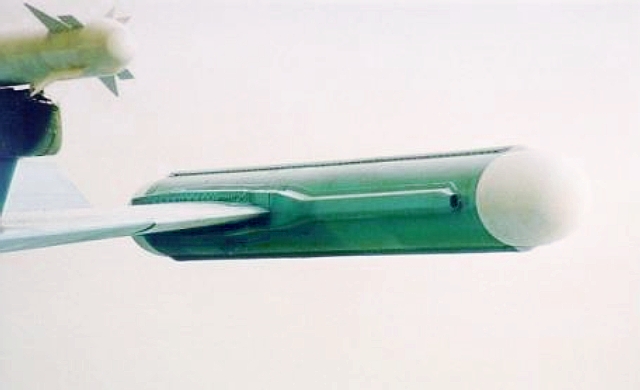 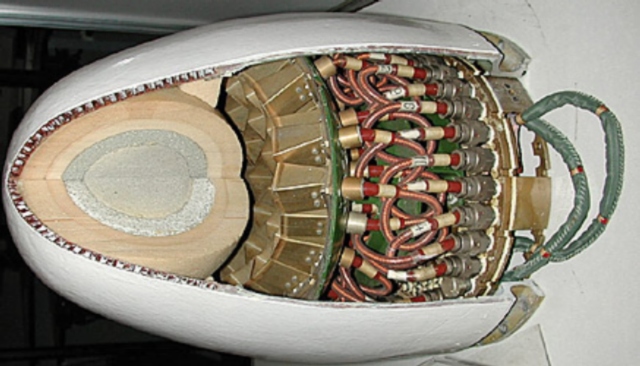
The KNIRTI L005S Sorbtsiya-S mid/high band defensive jammer is carried in wingtip pods. Unlike competing Western designs, this system uses a steerable mainlobe to maximise the Jam/Signal ratio at the threat emitter. The design uses a wideband phased array and dielectric lens arrangement (KNIRTI).
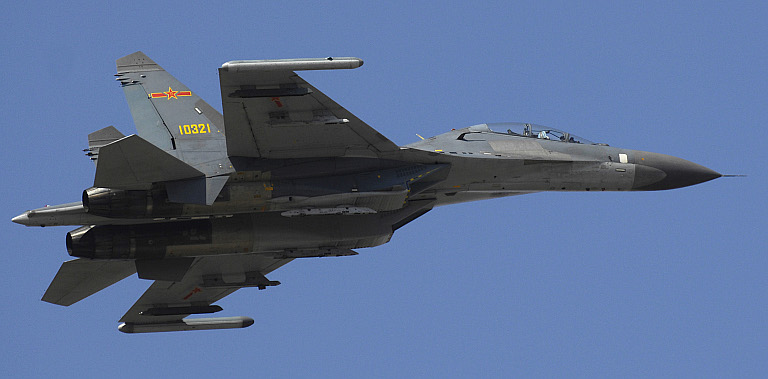 Electronic Warfare
Defensive systems in legacy and production Flankers include a Radar Warning Receiver, mostly variants of the SPO-32 / L150 Pastel digital receiver carried. The latest subtypes like the Su-35BM/Su-35-1 carry the KNIRTI L175M Khibiny M Radio Frequency Surveillance (RFS = ESM/RHAW) system, initially developed for the Su-34 Fullback. The Khibiny M is believed to use a channelised receiver and most likely employs a wideband dual baseline interferometer in the forward sector, to permit passive targeting of Kh-31P and R-27P/R-77P variants in defence suppression and air combat roles.
Newer Flankers carry the podded wingtip mounted KNIRTI SPS-171 / L005S Sorbtsiya-S mid/high band defensive jammer (ECM), this system being an evolution of a jammer developed for the Backfire C. The Sorbtsiya-S, unlike most Western jamming pods, is designed to operate in pairs and uses forward and aft looking steerable wideband phased arrays to maximise jamming effect, a similar arrangement to the Eurofighter Typhoon EWSP package. It is worth observing that the Sorbtsiya is clearly built to provide cross-eye jamming modes against monopulse threats, and the wideband mainlobe steering capability provided by the phased array permits best possible utilisation of available jamming power. A graded dielectric lens is employed. Russian contractors have been recently using Digital RF Memory (DRFM) technology, which is of the same generation as the US IDECM EWSP, and competing Israeli systems.
The most recent defensive jamming equipment to be offered on Flanker variants is the new KNIRTI SAP-518 wingtip jamming pod, displayed at MAKS 2009. Concurrently KNIRTI displayed a high power support jamming pod, the SAP-14, intended for centreline carriage on a large pylon. To date little has been disclosed on these pod designs, which are likely to retain the wideband phased array / lens antenna system first used on the Sorbstiya. 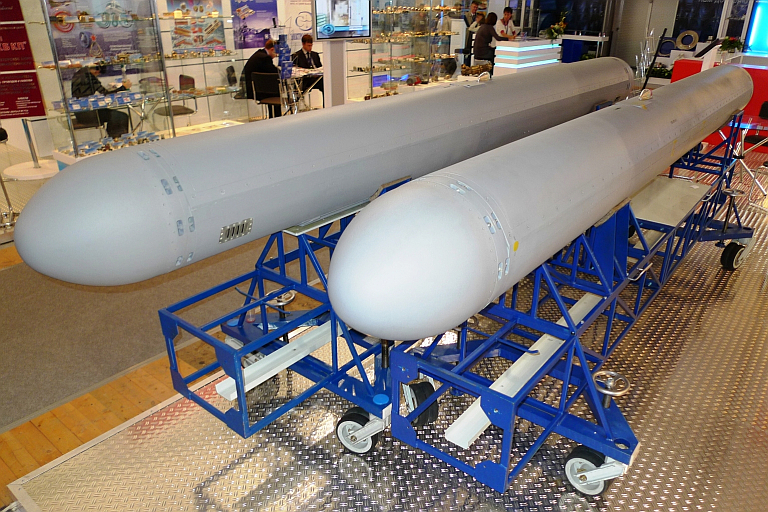 KNIRTI SAP-518 EWSP pods at MAKS 2009 (© 2009, Miroslav Gyűrösi). 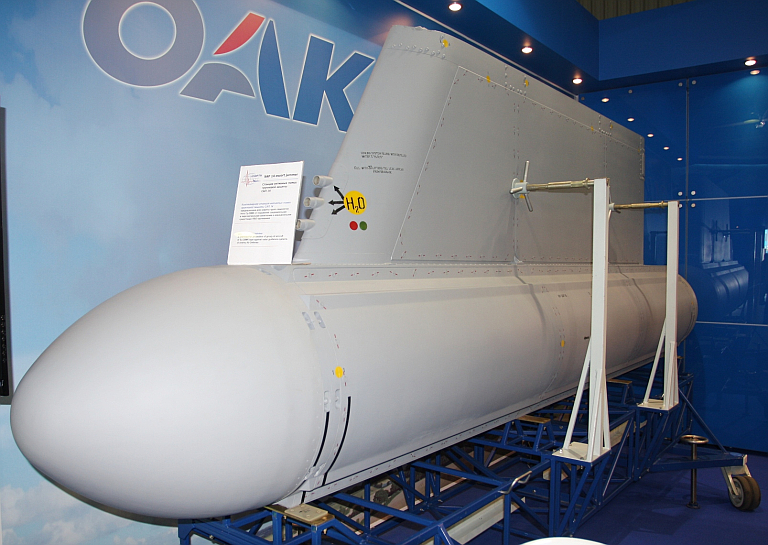
KNIRTI SAP-14 support jamming pod and centreline pylon on display at MAKS 2009 (© 2009, Miroslav Gyűrösi).

Su-30MKI Flanker H model with KNIRTI SAP-14 and SAP-518 jamming pods on display at MAKS 2009. The pods have already been flown on the Su-34 Fullback (© 2009, Miroslav Gyűrösi).
Propulsion - Supercruising Al-41F
In terms of propulsion, we have seen incremental improvements in the AL-31F series, with the F-3 model cited at 28,250 lbf cf the baseline F-1 at 27,600 lbf. KNAAPO/Irkut are offering TVC kits as retrofit items to existing models, as they are offering seamless engine upgrades.
Engine makers NPO Lyulka-Saturn and MMPP Salyut are now actively competing with block upgrades to the basic AL-31F turbofan. Salyut have described a three phase block upgrade to the AL-31F, with components for the first phase already flight tested. The -M1 upgrade sees the addition of the KND-924-4 0.924 m dia front end and SAU-235 FADEC, pushing the engine to 18,320 lb (75.21 kN) dry and 29,180 lb (129.8 kN) wet thrust. The -M2 upgrade phase implements a new cooling system for the turbine stages, pushing the engine to 31,082 lb (138.26 kN) wet thrust. The third -M3 upgrade stage sees the addition of a three stage blisk technology KND-924-3 front end boosting the compression ratio from 3.55 to 4.2, and wet thrust to 32,186 lb, competitive against the latest US F100 and F110 variants. NPO Lyulka-Saturn's competing upgrade, including hot end changes, is to increase wet thrust to 31,473 lb (143.17 kN). Salyut and Klimov are also working on a second generation TVC nozzle design. It is unclear when the 33,000 to 44,000 lbf class NPO Saturn-Lyulka AL-41F family will find its way into the Su-30 series. The AL-41F is the Russian equivalent to the F-22's F119-PW-100 engine, designed for supersonic cruise and improved performance across the full fighter envelope. Originally developed for the MiG MFI, the engine was built around the 'big bore' geometry already used in the AL-31F series, making it compatible with existing airframes. The AL-41F is reported to have recently entered Low Rate Initial Production (LRIP) the intent being to equip the Sukhoi Su-34 Fullback which recently entered LRIP. In 2004 an Su-27M/Su-35 Flanker E was flown with the prototype AL-41F1, a derated variant of the baseline AL-41F, intended to increase the performance of the Flanker across all flgiht regimes, and enhance dry supersonic thrust (http://www.flightglobal.com/Articles/2004/03/23/179164/Su-27M+flies+with+power+upgrade.html). The derated AL-41F1 is claimed to deliver 33,000 lb (145kN) of SL static thrust. 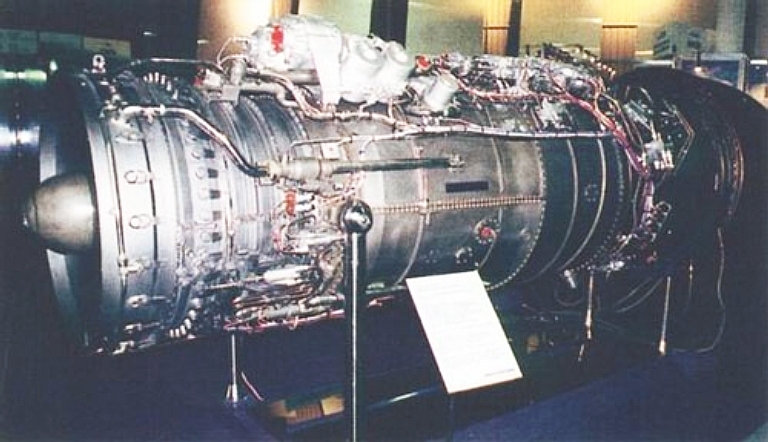
Al-41FU supercruise powerplant.
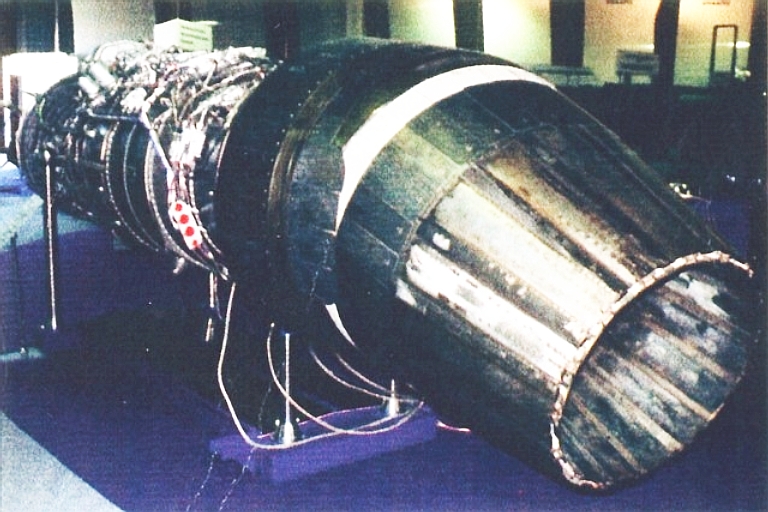
In terms of avionic systems and propulsion we can expect to see ongoing incremental growth in the Su-30 series, as market pressures drive KNAAPO and Irkut to integrate newer technologies in the aircraft. As the Su-30 is the primary export revenue earner in Russia's defence industry, and a primary means of exporting Russian guided munitions, it is apt to continue to be the platform for the deployment of the latest domestic and imported technologies. The unknown factor is how much modern EU and Israeli technology will find its way into the Sukhois over the next decade. With Germany, France and Israel active in the MiG MLU market the existence of Asian aggregrate fleet numbers around 600 or more aircraft will present an irresistable attraction for the sale of avionic and systems upgrades, be they incremental or major block upgrades.
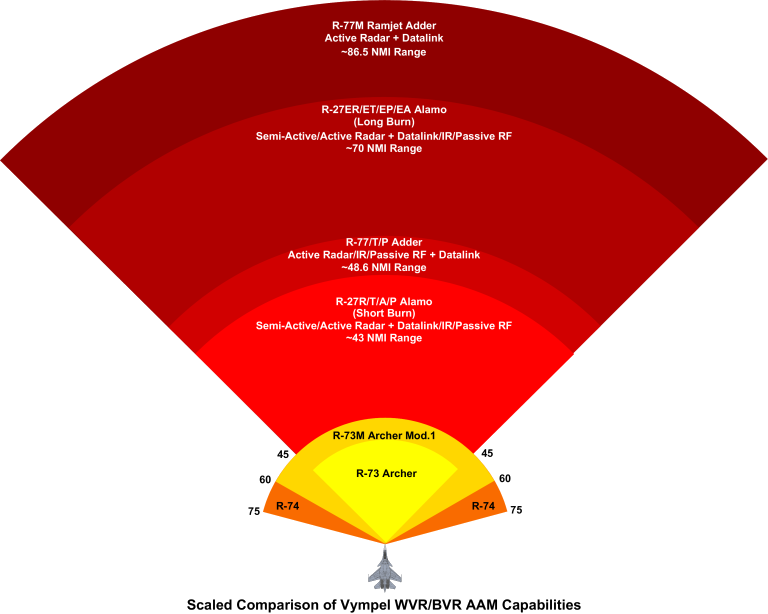 Air to Air Weapons
Air to air weapons are one area where the Russians have been very aggressively developing and marketing new products. The baseline Su-27S was armed with the R-27 (AA-10 Alamo) semiactive radar homing BVR missile and the R-73 (AA-11 Archer) WVR missile. The thrust vectoring R-73 (refer AA 4/97) was a trend setter and we have since seen an improved R-73M marketed, as well as a digitised seeker equipped R-74E variant credited with 75 degree off boresight capability and kinematics to kill 12 G targets. Indian press reports suggest the Rafael Python 4 has been offered to India and it is not inconceivable that this missile will find its way on to Indian and other regional Sukhois - India is currently negotiating for the Phalcon AEW&C system fitted to the Ilyushin A-50E airframe and has acquired ballistic missile defence radars from Israel.
The Vympel R-27 is the Russian equivalent to the late model US AIM-7 Sparrow series BVR missiles, but the similarity ends there since the R-27 is available in a plethora of variants. The basic airframe is supplied in long and short burn variants with differing range performance, and with heatseeking or datalink aided inertially midcourse guided semi-active radar seekers. The R-27R1 and R-27ER1 are the radar guided long and short burn versions, respectively, credited with F-pole ranges of 70 nautical miles and 43 nautical miles. The R-27T1 and R-27ET1 are the respective heat seeking equivalents, credited with slightly lower engagement ranges. The X-band anti-radiation seeker equipped R-27P/EP has been reported, designed to kill emitting fighters in the forward quarter by homing on their radar emissions. More recently Agat have offered new build or retrofit active radar seekers as the R-27A/EA, the AGAT 9B-1103M/9B-1348E, derived from the R-77 seeker.
The most recently exported missile in the region is the Vympel R-77 RVV-AE (AA-12 Adder), the AMRAAMski. This missile, with unique lattice controls, is a modern BVR weapon designed to kill 12G targets, and credited with an A-pole range of 54 nautical miles, although some reports suggest early production rounds are not delivering the kinematic performance advertised, not unlike early AIM-120A AMRAAMs. As the R-77 has AMRAAM-like capabilities, it permits an Su-30 to launch multiple rounds and guide these concurrently, engagement geometry permitting. As the R-77 matures, we can expect to see refinements in propellants, autopilot kinematics and seeker jam resistance.
We have yet to see reports of regional deliveries of the Vympel R-77M RVV-AE-PD (Povyshlenayya Dal'nost') ramjet adder, credited with an A-pole range around 80 nautical miles. This missile is a direct derivative of the R-77.
Alternate seekers for the R-77 have been advertised - the heatseeking R-77T using an MK-80M seeker from the R-73M and R-27T, and the antiradiation R-77P. The deployment of the new F/A-22A later in the decade will see significant pressure on Vympel to supply heatseeking, anti-radiation and electro-optical imaging seekers on the R-77/R-77M in an attempt to counter the combined kinematics and all-aspect stealth of the F/A-22A. While such seekers may do little to offset the overwhelming advantages of the supercruising F/A-22A, they are likely to prove quite effective against inferior types such as the JSF, F/A-18E/F, late model F-15E and F-16C/B50. If the Su-30 can close to a range where an advanced longwave IRST can track the target, an optical seeker equipped R-77 variant can be used to effect an engagement, defeating the RCS reduction measures on these aircraft. The anti-radiation R-77P could be used to engage at maximum missile range.
In the long range missile domain, the Vympel R-37 (AA-X-13) series of AIM-54 Phoenix look-alikes have been proposed - a developmental R-37 successfully engaged a target at 162 nautical miles of A-pole range in 1996. A more interesting proposal has been the use of the Novator R(KS)-172 RVV-L (AAM-L) missile, a 215 nautical mile range 1,650 lb launch weight long range AAM. The R-172 uses datalink/inertial midcourse guidance and an active radar terminal seeker, and Russian sources claim a snap-up capability to 100,000 ft and snap-down capability to 10 ft AGL. KS-172 mockups have been photographed on Su-30 displays but its production status is unclear at this time, although India is negotiating licence production.
Of no less interest is the Kh-31P (AS-17 Krypton) family of ramjet anti-radiation missiles, offered as a standard store on the Su-30/35 subtypes. This missile, in basic anti-radiation and dual mode seeker variants is often dubbed the AWACS killer and would be used to destroy opposing AEW&C aircraft, or surface based radars. Sukhoi advertise a load of up to six rounds, two on the inlet stations.
| ||
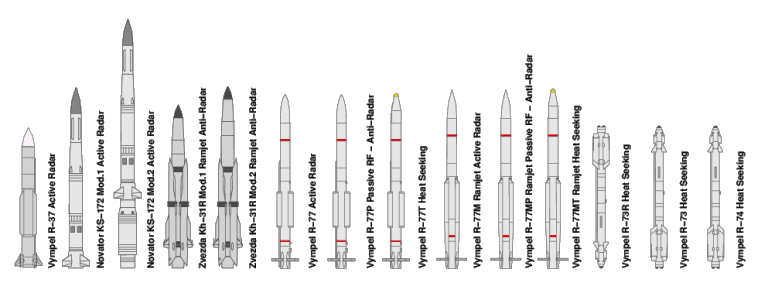
Russian missiles either carried by or proposed for Flanker variants (Author).
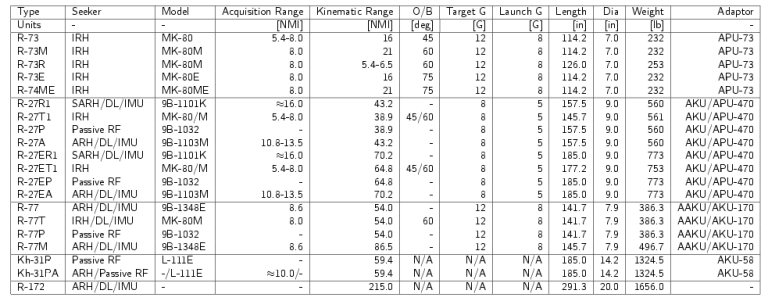
Notes: O/B - seeker off-boresight acquisition angle; IRH - heatseeking, single or dual colour scanning seeker; SARH - semi-active radar homing seeker; DL - datalink for midcourse guidance corrections - either analogue or digital; IMU - inertial package for midcourse guidance; Passive RF - passive radio frequency anti-radiation seeker; ARH - active radar homing seeker; Acquisition Range is that at which the seeker can acquire its target; Kinematic Range is A-pole or F-pole; Target G - max load factor of target vehicle; Launch G - max load factor of launch aircraft; APU - Aviatsionnaya Puskovaya Ustanovka (rail launcher); AKU - Aviatsionnaya Katapultnaya Ustanovka (ejector); This is a current open source compilation based on manufacturers' and third party data therefore figures should be treated with appropriate caution (Author).
 | ||
The dominance of US ISR capabilities is producing an increasing demand for hard kill 'counter-ISR' weapons and the Sukhoi fighter equipped with missiles like the Vympel R-77M, R-37, Novator KS-172 and Zvezda-Strela Kh-31 variants qualifies exactly as that.
It is clear that the Su-30 has at least two decades more of yet to be exploited technological growth capacity, especially in systems and weapons. The excellent kinematics, large airframe and large apertures give it a decisive long term advantage in growth potential against all teen series types, and with an increasingly borderless international upgrade market, regional users with the cash required will be able to fit some very capable upgrades over time.
We can summarise growth options thus (IASC, 2006): | ||
Supersonic cruise 40,000 lbf class AL-41F engines replacing the AL-31F.
Thrust vectoring (TVC) engine nozzles with 2D or 3D capability.
Digital Flight Control System (DFCS) becoming standard for late build Flankers. The Su-37 included redundant sidestick controls for the pilot.
Canard foreplanes for enhanced high alpha agility. Production hardware on Su-33 and Su-30MKI. An active phased array (AESA) fire control radar replacing the N-001 and N-011/011M series. A two color band FLIR/IRST sensor replacing the OLS-30, using QWIP imaging array technology. COTS based computer hardware running COTS based software. A Helmet Mounted Display with FLIR projection capability. Such an upgrade was being discussed some years ago, and would be easily accommodated with a FLIR/IRST sensor. Full glass cockpit based on digital technology. Given the current delivery of first generation glass cockpits in Su-30MK and Su-27SKM, this is a natural progression. Heatseeking and anti radiation variants of the R-77 Amraamski, and extended range ramjet powered variants of the R-77. All are in advanced development and actively being marketed. Advanced digital variants of the R-73/74 Archer close-in air to air missile. These have been actively marketed. AWACS killer long range missiles in the 160 to 200 nautical mile range category. The R-37/AA-X-13 Arrow remains in development for the Su-35, the R-172 was recently reported as the subject of licence negotiations with India. Su-35 upgrade marketing literature depicts the use of such missiles. Cruise missiles for standoff attacks. China acquired Kh-55SM/AS-15 Kent cruise missiles from the Ukraine, and is manufacturing indigenous designs. India intends to use the supersonic Brahmos on its Su-30MKIs. Advanced jam resistant fighter to fighter and fighter to AWACS datalinks and networks. Further evolution of protocol software will see this technology grow to match current US capabilities. Radar absorbent materials for radar observables reduction. Numerous Russian unclassified papers detail a range of technologies for surface wave suppression and edge signature reduction, with a specific aim of reducing legacy aircraft observables. Aerial refuelling probes, pylon plumbing for drop tanks, and buddy refuelling stores. Production hardware available off the shelf. | ||
Su-30 vs RAAF AlternativesMany visitors will be asking the obvious question of how the Sukhois stack up against theF/A-18A HUG, the JSF panacea and recently proposed interim fighters such as the F/A-18E/F.Against all three types the Su-30 derivatives, especially with later engine subtypes, will always have a significant kinematic advantage - there is no substitute for thrust in the kinematic performance game. There is another factor to consider here, which is the superlative 10 tonnes of internal drag free fuel the Sukhoi carries. When not operating at extended combat radii, the Sukhoi driver has more fuel to convert into energy, and that energy can nearly always be used to an advantage. With mutually competitive WVR missiles and Helmet Mounted Sights/Displays for close-in combat, all three types will live or die in a close in engagement with an advanced Su-30MK variant by pilot ability and good or bad luck. The Sukhoi combines high alpha manoeuvre capabilities with excellent thrust/weight performance, and is apt to have an energy advantage entering and prosecuting a close in fight. A JSF driver opting to engage a thrust vectoring late model Su-30MK in a knife fight may not survive to speak of the experience, unless the Sukhoi driver is unable to exploit his advantage properly. In close in air combat terms the JSF qualifies as 'double inferior' against the later model Sukhois, since the Sukhois have an advantage in both thrust/weight ratio and in wing loading (interested visitors refer R.L. Shaw's Fighter Combat), and with its canard and thrust vectoring capability will generally be able to gain a firing solution quicker. Because the JSF is designed within the kinematic performance class of the F/A-18 and F-16, it is right in the middle of the performance envelope of aircraft the Sukhoi was designed to kill. 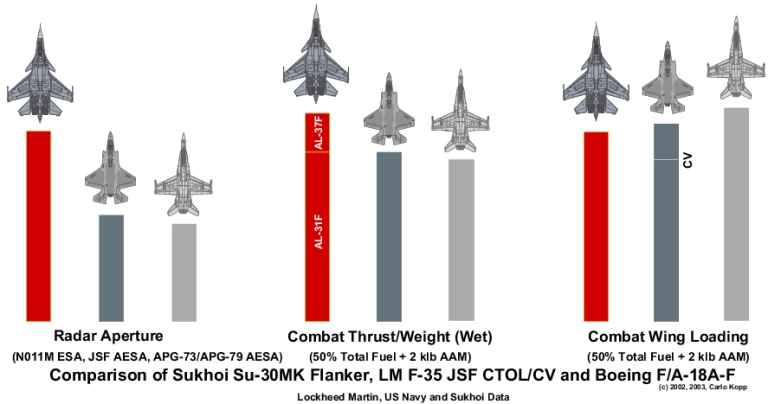 In Beyond Visual Range (BVR) combat, the Sukhoi will again have a kinematic advantage, which may be exploitable at the bounds of engagement radii, as the Sukhoi can gain separation in and out of the missile envelope of the F/A-18's and JSF faster - it has the extra thrust and combat fuel to play kinematic games both smaller fighters cannot. The BVR game is however dominated by sensor capabilities, both onboard and offboard the fighters, and long range missile capabilities. The F/A-18A HUG is wholly outclassed by an Su-30MK with an N011M phased array and R-77M ramjet missile. A late model F/A-18E with minimal external stores and the APG-79 AESA fares much better due to its radar signature reduction measures and better radar power-aperture performance, but with external stores its margin of survivability is eroded and it is likely to fall well within the engagement envelope of the Sukhoi and also come to grief (refer radar/missile plot). A post 2010 AESA equipped Sukhoi could almost certainly take on the F/A-18E with confidence as it will have much better power-aperture capability in the radar, enough to offset the radar signature reduction measures in the F/A-18E/F, with an advanced IRST to supplement radar data. | ||
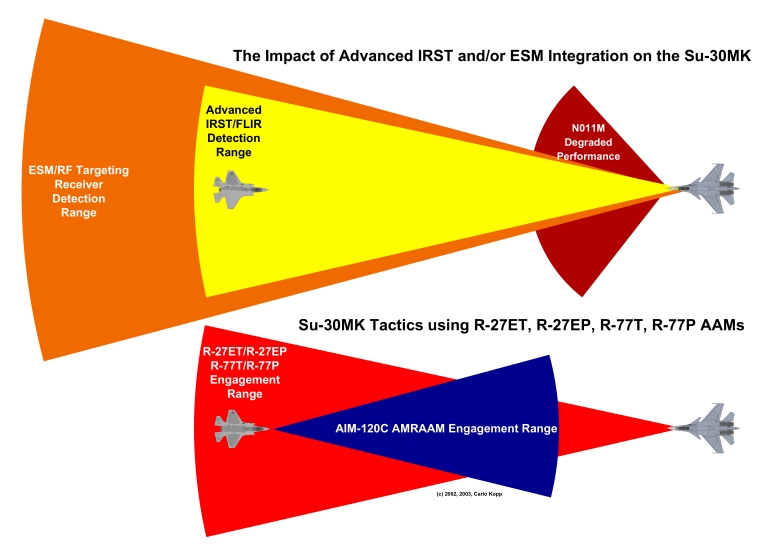 A clean JSF will have the advantage of a very low X-band radar signature in the forward quarter which will significantly degrade the Sukhoi's otherwise overwhelming radar power-aperture advantage over other types. However, the JSF is not designed to be a hot supersonic performer and like the F/A-18s will need to generously use afterburner to effect an intercept against a rapidly penetrating Sukhoi. This exposes the JSF to detection and tracking by a newer technology IRST, and engagement by a long burn heatseeking or optically guided AAMs such as the R-27ET, R-77T or likely future variants with imaging seekers analogous to the AIM-9R and ASRAAM seekers. With the latter seekers an R-77/R-77M acquires many of the capabilities of the RAAF's superlative ASRAAM, especially jam resistance, but in a long range missile with datalink midcourse guidance. A new two-colour infrared seeker with 10.8 nautical mile acquisition range has been announced by the Arsenal infrared systems house, ostensibly for use on the R-77 series. Professionals might contemplate that these are not 1980s 36T series seekers. Russia and the Ukraine have a competent infrared systems industry - e.g. Cyclone JSC recently described their QWIP single chip thermal imagers with 128x128 and 320x256 resolution, competitive against the latest EU technology and suitable for missile seekers and thermal imaging IRST detectors. Therefore an advanced derivative of the OLS-30/31 series with capabilities similar to the Eurofighter PIRATE thermal imaging IRST, but with better detection range, will be implementable with Russian hardware in the latter half of this decade given the current rate of evolution. In the beam and aft sectors the JSF may be also quite vulnerable to an active or semiactive radar guided missile shot - its beam and aft sector radar signature reduction is much less refined than that in the forward sector. Another factor for the JSF is its radar emission - making it vulnerable to a long range shot with an anti-radiation seeker equipped R-27P, R-27EP, R-77P or when eventually deployed, ramjet R-77MP. While some Low Probability of Intercept (LPI) techniques may reduce vulnerability to anti-radiation missiles, radar modes for closing missile shots typically require high update rates and favour the anti-radiation seeker. Since the R-77/R-77M has a midcourse inertial package - Agat are developing FOG (fibre) gyro technology to avoid dependency on Western Ring Laser Gyro technology - transient loss of the JSF radar emission may not defeat the R-77P/R-77MP - or late model R-27P/EP. Soviet and more recent Russian BVR doctrine has always emphasised firing pairs of missiles, one with heat-seeking guidance and one with radar guidance, to defeat countermeasures. With the option of active radar, heat-seeking and anti-radiation seekers, and by the end of the decade an imaging seeker, the result is a very lethal cocktail from a defensive countemeasures perspective - a defending fighter may only have datalink transmissions to provide warning and no indication of the seeker mix on the inbound missiles. With three of the four seeker technologies passive defeating such weapons is not trivial. On publicly available data the JSF is likely to be detected and engaged by an N011M ESA equipped Su-30 inside the 10 to 20 nautical miles head on range envelope, unless the JSF can get the first shot off and successfully kill the Sukhoi. If the Sukhoi can close with the JSF, all bets are off on the JSF's ability to survive the close in engagement.A view commonly heard in Canberra these days is that the use of the Wedgetail AEW&C to provide offboard targeting for the JSF will provide a decisive advantage over the Sukhois - 'Network Centric Warfare' will ostensibly offset all other deficiencies in the force structure and platform capabilities. This argument is clearly contingent upon a great many 'ifs' - if the Sukhois do not shoot very long range missiles at the Wedgetail to force it to shut down or indeed kill it, if the Wedgetail MESA is not jammed, if the JTIDS/MIDS or other datalinks to the fighters are not jammed, if the Sukhois are not carrying advanced IRSTs or X-band homing receivers, and if the Sukhois are not supported by HF or low VHF band radars. If a JSF were deployed in 2005 with a supporting Wedgetail and existing Su-30 capabilities, then the argument probably holds most of the time. However, in a post 2010 environment it is most likely not going to hold up most of the time. If Iraq could acquire smuggled Russian GPS jammers during a UN arms embargo, there is no guarantee that equipment like high power L-band jammers, advanced IRST, ESM receivers, long range ramjet powered anti-radiation missiles and low band radars will not proliferate into the region - the Kh-31P has been already been reported in use with the PLA-AF. Given the mistrust of the US and its allies we see in many regional players, be it the PRC or lesser nations, the odds are very good that the existing trend will persist and the most advanced Russian hardware, and indigenous equipment, will be widely used. While this will not put a dent into the US Air Force's stealthy supercruising F-22A fleet, it is likely to make life very difficult for the USN with a planned force structure of F/A-18E/Fs and JSFs. If the RAAF opts for the JSF as its single type solution, and F/A-18F as an interim types, it is likely to experience similar grief. In the long term the Russians will find a growing market for 'Counter-ISR' weapons - the 215 nautical mile R-172, 160 nautical mile R-37 and 60 nautical mile Kh-31 series. In any engagement against a Western air force, the first wave of Sukhois would shoot long range 'AWACS-killer' weapons such as the R-172, R-37, Kh-31 - or types as yet unknown - to either destroy the AEW&C/AWACS or force it to shut down and retreat - the 'AWACS-killer' theme is frequently seen in Russian marketing literature , statements and more recently promotoional video footage. The result is that forward defending CAPs have to then light up their radars to attempt to function autonomously - in turn making them vulnerable to detection by ESM and shots by anti-radiation missiles like the R-27EP or R-77P/MP. This Russian doctrine of a deluge of long range missiles is not new - it is a variation on their proven theme of attacking naval task forces with long range missiles. It is an evolutionary adaption to the growing dependency of Western air forces on large and vulnerable ISR platforms - the E-3 AWACS, RC-135V/W Rivet Joint, E-8 JSTARS, E-10 MC2A and of course the RAAF's new Wedgetail. The reality is that of an evolving technological landscape in which advanced conventional weapons and supporting technologies proliferate often very rapidly. The rate of Su-30 uptake in the region is a good case study - any nation with the cash can acquire very quickly large numbers of top-tier combat aircraft often with the latest Western avionics and Russian weapons and sensors fitted. | ||
|
The acquisition of long range Su-27SK/30MKK fighters and supporting Il-78MKK aerial refuelling tankers provides the PLA-AF with unprecedented reach across the near region (C. Kopp). | ||
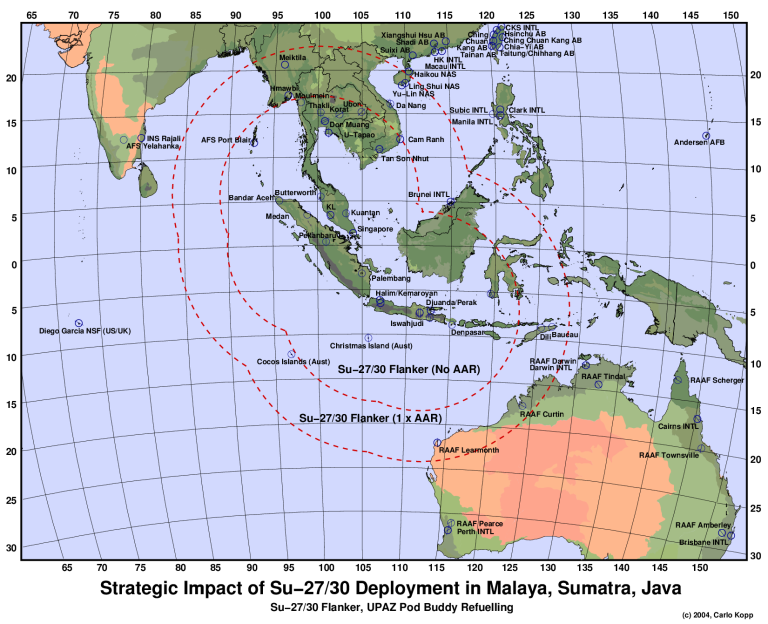
The arrival of the Su-27/30 series fighters in this region changes Australia's strategic context significantly. The superb combat radius of these large aircraft provides a significant capability to cover the sea-air gap (C. Kopp).
| ||
Strategic Impact of Su-30 in the Region
We have yet to see the full strategic impact of the Su-30 proliferating in the nearer and wider region. India and the PRC will not have most of their Sukhoi force structures deployed until 2015 or later, and it is unclear how many Sukhois both Malaysia and Indonesia will ultimately operate. In the near term, both Indonesia and China will have difficulties with fully exploiting the aircraft as they have steep learning curves to climb in training and support - India and Malaysia are apt to fare much better with Western based training systems. We can expect to see regional users of the Su-30 maturing their capabilities to use the aircraft in the latter part of this decade. Much has been said about the PRC's difficulties in recruiting and training competent Sukhoi drivers - with a population base of over a billion it is however only a matter of time before they learn to do this properly. The view widely held in some Canberra circles that Asia's air forces will remain at current proficiency levels is not supportable in the longer term.
Much has been made of the serviceability and support problems experienced by the IAF and the PLA-AF with their initial Sukhoi aircraft, indeed the Indian government audit public report listed a litany of contractual problems and Su-30K/MK servicabilities as low as 50% in 2003. These problems should been seen in the proper context as they represent the transient state experienced when introducing a radically new piece of technology and supporting systems. The Sukhois are a generation beyond the MiG-29 Fulrcums flown by the IAF and two generations ahead of the 1950s technology which makes up the backbone of the PLA-AF. With HAL and Shenyang to perform domestic assembly and part production, in time both nations will have the ability to domestically manufacture high failure rate components, and perform factory/depot deep overhauls. As a result what we see now in the support base for the aircraft will not persist and should not be used as an indicator of the long term supportability of the aircraft. With large fleet sizes even a large proportion of grounded aircraft still leaves strategically significant numbers to cause mayhem with.
Another factor in time will be the availability of third party Indian and Chinese made spares to other Sukhoi users in the region. Bottlenecks in the supply of Russian made spares may not persist past 2010 since the commercial incentives to bypass Russian suppliers are considerable - and many regional Sukhois will use substantial fractions of Western avionic hardware. In time we can expect to see more bilateral deals, of the ilk seen between India and Malaysia for MiG-29 support, emerging between regional players and this will change the support environment seen by smaller regional users of the aircraft. With four sources of spare component supply rather than one - Irkut, KNAAPO, HAL and Shenyang lines and subcontractor pools - market forces will have their impact. To assume that historical case studies of Russian aircraft support will be representative of the longer term future in this region is arguably to misunderstand the developing dynamic across the region. The era of Cold War technology monopolies is long gone - only the US can sustain such due its commanding lead in stealth, propulsion and computing technologies. This model is not a valid one for assessing the longer term regional situation in Russian and third party hardware.
The Su-30s are 'honest' 700+ nautical mile radius class fighters, with plenty of combat gas to burn at shorter radii. This provides all of the Sukhoi operators with a much larger air defence footprint than we have ever seen before. India is now taking delivery of its six Il-78 Midas tankers and will be able to robustly project their Sukhoi force well beyond their borders - China ordered six Il-78MKKs in late 2005.
Even without a proper tanking capability, lesser regional players have the option of buddy refuelling Su-30s with the UPAZ hose/drogue pod - at the expense of half of the force committed to tanking sorties. On a buddy refuelling sortie the shooter gains around 200-250 nautical miles of radius - yielding a radius very close to 1,000 nautical miles. With a 200 nautical miles class standoff missile such as a 3M-54E or Kh-41 variant, both advertised on Sukhois, this provides a limited strike capability beyond a 1,000 nautical miles radius. While such a strike refuelling technique is not viable for sustained high intensity operations, it is feasible for nasty pinprick raids against very high value assets, such as airfields, petrochemical/gas plants, shipping, aircraft carriers and other targets the destruction of which could be highly politically embarrassing to the victim.
What this means in practical terms is that Su-30 users will have the potential to contest airspace up to 500 nautical miles or further from their runways, and launch limited strikes out to around a 1,000 nautical miles radius. While the latter is not the kind of heavy iron 1,000 nautical mile radius capability Australia possesses in its F-111 fleet, it is nevertheless enough capability to cause considerable mayhem, if used cleverly.
In the longer term the Sukhoi will have several strategic effects. The first is that it will provide its users with the ability to threaten or intimidate neighbours with lesser capabilities, if they fall within the footprint of the Sukhoi. The second is that the US Navy's CVBGs will lose much of their ability to intimidate by gunboat diplomacy - the ability to threaten a CVBG with a mixed package of shooter and escort Su-27/30s to radii essentially greater than that of the F/A-18E/F and JSF mix on a carrier deck drives up the risk for the US Navy in a nasty political stand-off. Unless the US is prepared to take the gloves off early in a dispute and deploy the F-22A centric US Air Force Global Strike Task Force, the US Navy may cease to be a viable tool for coercive diplomacy.
Even for the US Air Force the Su-30 presents some interesting challenges, since it has the radius to threaten both tankers and large ISR platforms in a shooting contest. While the F-22A would deal with the Sukhois quickly and effectively, in many scenarios the Sukhois could create genuine complications by forcing a relatively high ratio of F-22A escort sorties to F-22A strike sorties, thus diminishing the strike sortie rate - a major issue for the dual role tasked F-22A fleet.
Another factor to consider is the ongoing proliferation of advanced guided munitions and other hardware produced by competing Russian vendors. Just as we have seen Irkut and KNAAPO competing in the sales of Sukhois, we have seen a wide range of Russian weapon makers like Vympel, Zvezda, Raduga and others selling their products across the accessible market. Many of these products incorporate modern Western digital COTS technology, an example being the upgraded second generation 9B-1103M active radar seeker for the Vympel R-27A/EA missile, which is built around a Texas Instruments TMS320C44 digital signal processor chip and achieves a 25% acquisition range improvement over the baseline seeker, derived from the R-77's first generation 9B-1348E - a second generation '9B-1348ME' will almost certainly carry the same TMS320C44 digital signal processor.
Some of the air-surface weapons being offered for the Sukhois are genuinely capable. The Raduga Kh-41 Moskit (3M-80/82 SS-N-22 Sunburn) has been integrated on the Sukhois' centreline station (Su-33) and is considered to be one of the most lethal supersonic sea skimming anti-ship weapons in existence. The NPO Soyuz/Turayevo TKMB ramjet powered Mach 4 class Zvezda-Strela Kh-31 (AS-17 Krypton) is offered on Sukhoi variants, both in the active radar anti-shipping A model (PLA-N) and anti-radiation P model (PLA-AF). The latest advertised Kh-31 variant includes a dual mode air-air seeker, incorporating an active radar seeker and passive anti-radiation seeker, optimised for engaging 'nonmaneuvering airborne targets such as AWACS' out to 100 nautical miles. Both the supersonic OKB-52 P-800/3K-55/3M-55/Kh-61 Yakhont / Brahmos (SS-N-26) and Novator 3M-54 Club (SS-N-27) have been publicly discussed as options for the Sukhoi fighters, especially the Su-34 series, but it is unclear whether any integration work has taken place to date.
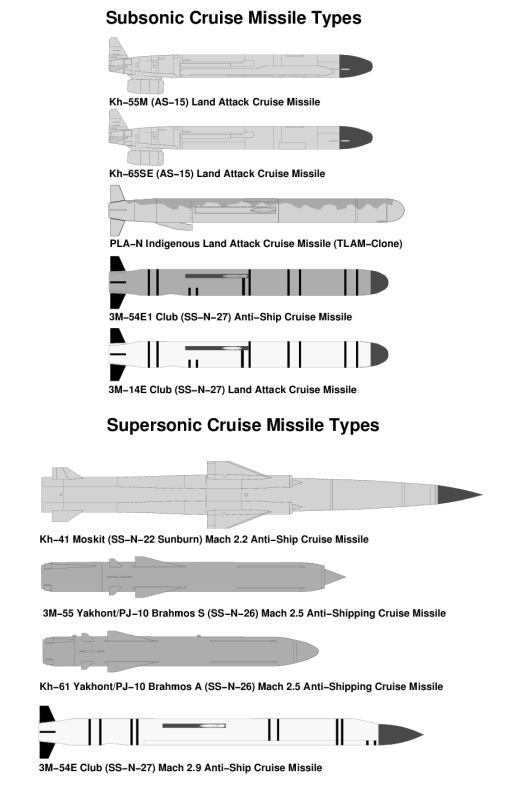 Cruise missiles integrated on or proposed for the Flanker (Author).
For strikes against land targets, the 1,500 lb class Molniya Kh-29 (AS-14 Kedge) is available in television (Kh-29T), thermal imaging contrast lock homing (Kh-29D) and semi-active laser homing (Kh-29L) variants - the weapon is a direct equivalent to the very effective French Aerospatiale AS.30 series, with the television and thermal imaging guided variant seeker equivalent to the AGM-65 Maverick series. The smaller semi-active laser homing S-25LD and Zvezda Kh-25ML (AS-12 Kegler) are also on offer. An equivalent to the RAAF's AGM-142 is available in the 2,000 lb class 50 nautical mile range turbojet sustained Raduga Kh-59M (AS-18 Kazoo), which uses a conceptually similar TV/datalink guidance scheme, using an APK-9 Tekon datalink guidance pod carried on the left inlet pylon. An anti-radiation variant, the Kh-59 (AS-13 Kingbolt) is available but has not been advertised on the Sukhoi - the newer Kh-31R series appearing to be favoured by the market.
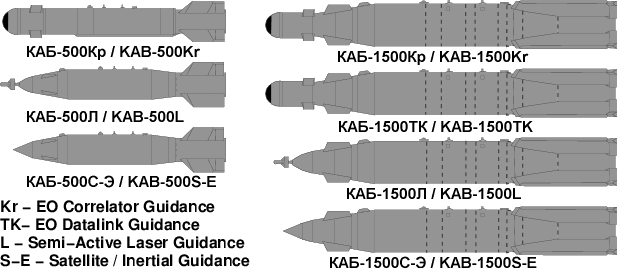
GNPP KAB-500 and KAB-1500 guided bombs (Author)
The Russians are also actively marketing guided bomb kits for the Sukhoi fighters. The KAB-500L is a direct equivalent to the GBU-16 using the 27N series laser seeker, the KAB-500Kr is equivalent to a TV contrast lock guided 1,000 lb GBU-8 HOBOS fitted with a bunker busting or fuel air explosive warhead. The KAB-1500 is a family of guidance kits for 3,000 lb class dumb bombs, available with unitary or bunker busting warheads. The KAB-1500L is a semi-active laser homing kit, the KAB-1500TK a TV command link guided kit analogous to the GBU-15 but 50% bigger, and the KAB-1500Kr a TV contrast lock guided system. Either three of the 1,500 kg weapons, or six of the 500 kg weapons can be carried by an Su-27/30 with suitable avionics.
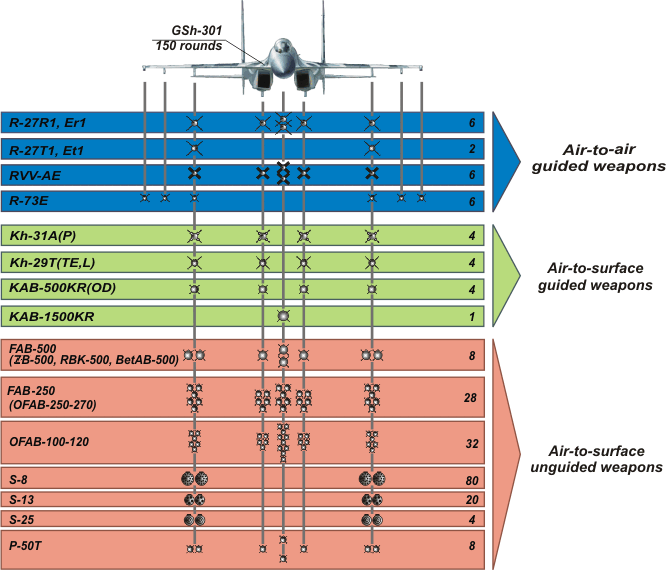
Su-27SKM loadout (Sukhoi).
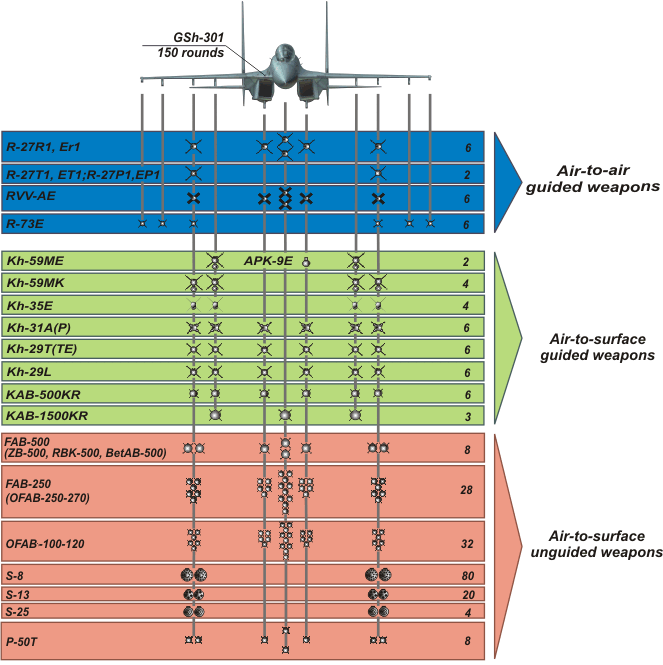
Su-30MK loadout (Sukhoi).
To date most regional users have invested in Sukhois primarily to provide air superiority capabilities. The availability of a wide range of competitively priced Russian guided weapons is likely to result over time in an increasing broadening of the role of regional Sukhoi fleets. The principal impediment to the wider use of Russian laser guided bombs has been a shortage of good targeting pods - with suitable laser coding modifications third party pods are likely to evolve to fill this niche over the next decade. The impact of the US GBU-12 in Afghanistan and Iraq will not have gone unnoticed.
The television guided KAB-500Kr and KAB-1500Kr kits are also worth closer scrutiny, since they provide a fire-and-forget capability very similar to the long retired GBU-8, or a GBU-15 used in lock-on-before-launch mode - highly accurate and devoid of the need for a targeting pod. With the potential for a pre-programmed scene matching correlation capability (ie pre-loading the bomb with a digitised target image not unlike the early Tomahawk DSMAC), a technology the Russians do have, this presents the prospect of a JDAM like capability to attack multiple aimpoints on a single pass, albeit daylight limited. The large volume of the KAB series seekers would easily permit a lot of evolutionary growth in the design, and low cost commodity processing chips and QWIP thermal imagers would facilitate this. It is likely that we will see more of this family of bomb seekers in time.
Russian sources claim the PRC has ordered the Kh-59ME stand-off missile, the Kh-29T TV guided missile, the Kh-31R anti-radiation missile, and the KAB-500Kr electro-optically guided bomb kit. PLA-AF Su-27SKs have been seen carrying paired KNIRTI L005-S Sorbtsya wingtip jammer pods designed to defeat the APG-63/65/68/70/73 radars and Hawk/Patriot SAM systems.
| ||
Conclusions
For Australia the Su-30 presents the prospect of a more difficult to defend sea-air gap. While we might choose to argue ad nauseam as to whether a future Indonesian regime might opt to get into a fight with Australia, or debate the likelihood of PLA-AF Sukhois being based in the northern apporaches at a future date, or debate India's future role in the near region, the stark reality is that the tyranny of distance which has protected Australia for decades is being rapidly eroded by developing capabilities across the region.
In this context the 2002 JSF decision, and ongoing lobbying for F/A-18E/F interim fighters, seem both to be quite incongruous. Neither aircraft offers a decisive capability margin against the Su-30 series, especially longer term as the sensors, avionics and weapons evolve in the Sukhois and regional players acquire AEW&C aircraft and other supporting capabilities.
Indeed, one idea popular in some Canberra circles seems to be that the RAAF is now less needed and should be downsized to save money since Indonesia is in a state of chaos and all the RAAF is needed to do is participate in the odd US coalition force - of course if anything goes really bad in our neighbourhood the US will instantly assist!
This is a particularly lame argument insofar as the US Air Force is badly stretched with worldwide commitments, and is having genuine difficulties with a poorly ageing tanker and fighter fleet - in a crisis the US may not be in the position to deploy sufficient assets quickly enough, even if the then incumbent US administration wants to do so. There is of course no guarantee that a future US leadership group will have the kind of relationship with Australia which we observe today. The Americans may not solve their block obsolescence problems until later in the next decade, leaving a genuine window of strategic vulnerability should the more vocal proponents of RAAF capability reduction have their way in Canberra.
The belief in some Canberra circles that the JSF will somehow solve all of the RAAF's force structure problems does not stand up to scrutiny, in the light of the known capabilities and demonstrated growth potential of the Sukhoi Su-30 which is rapidly becoming the 'standard' fighter across the region. Similarly the belief that F/A-18E/F interim fighters will somehow address the capability gap in the F/A-18A HUG fleet is hard to accept. The belief that the F-111's heavyweight counter-air strike capability is now irrelevant also conflicts with the reality that the best way to fight an Su-30 without an F-22A is to shut down its basing from day one of a conflict - and if possible convert the Sukhois to scrap metal in situ - neither achievable with a handful of standoff missile shots.
Strategy has always been a game of positional advantage, and in the modern age this positional advantage lies largely in air power. If Australia is to retain its relative strategic position in the region it must start thinking realistically about its long term force structure and abandon the quick fix panacea solution mindset which seems to be so prominent in the current Canberra defence debate. There are no quick or cheap fixes in this game.
| ||
Further Reading
Sukhoi/KnAAPO Su-35-1/BM/S Flanker Analysis
Shenyang J-11B Flanker B Sukhoi Su-33 and Su-33UB Flanker D: Russia's Maritime Multirole Fighter Flanker Radars in Beyond Visual Range Air Combat The Russian Philosophy of Beyond Visual Range Air Combat PLA Air to Air Missiles Soviet/Russian Guided Bombs Soviet/Russian Tactical Air to Surface Missiles Soviet/Russian Cruise Missiles F/A-18E/F Super Hornet vs. Sukhoi Flanker Assessing Russian Fighter Technology | ||
References
| ||

Imagery Sources: Author; Rosoboronexport; Russkaya Sila; Vestnik PVO; MilitaryPhotos.net; Military.cz; XinHua
Line Artwork: © 2003, 2007 Carlo Kopp |

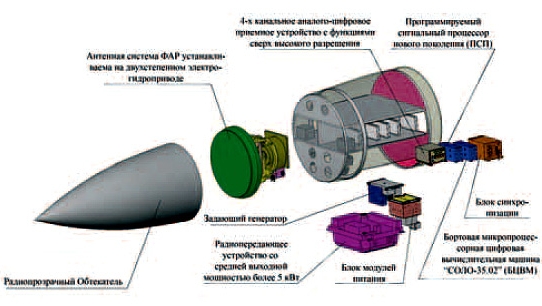
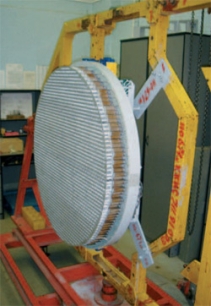
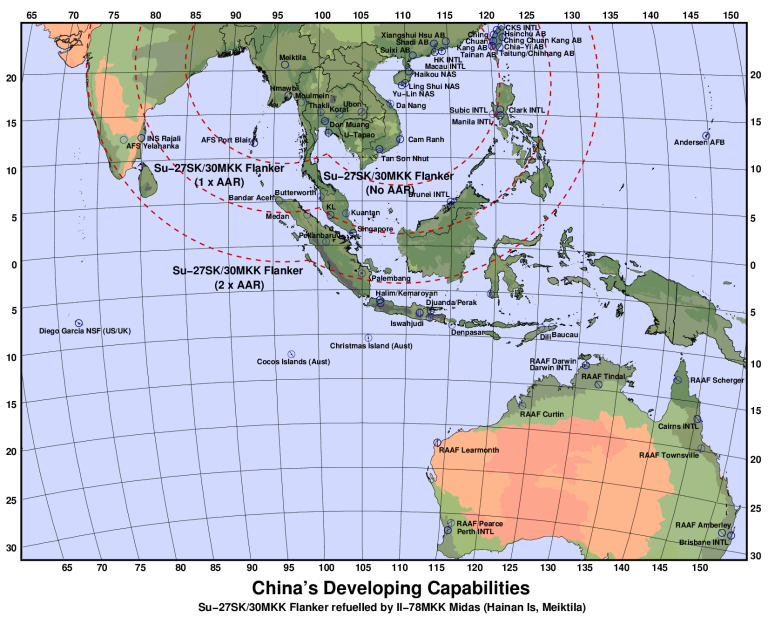












0 komentar:
Posting Komentar